I just spent two incredible weeks exploring Northern Italy, and I can honestly say it was the perfect mix of adventure, relaxation, and breathtaking scenery. My journey began with a week on the sparkling shores of Lake Garda, where I wandered through charming lakeside towns, indulged in gourmet meals, and enjoyed boat rides on the turquoise water. Then I traded the tranquil lakes for the dramatic peaks of the Dolomites, hiking iconic trails, discovering hidden valleys, and unwinding in luxurious mountain retreats. From serene lakes to towering mountains, this trip gave me a firsthand experience of Northern Italy at its most beautiful and unforgettable.
Lake Garda:
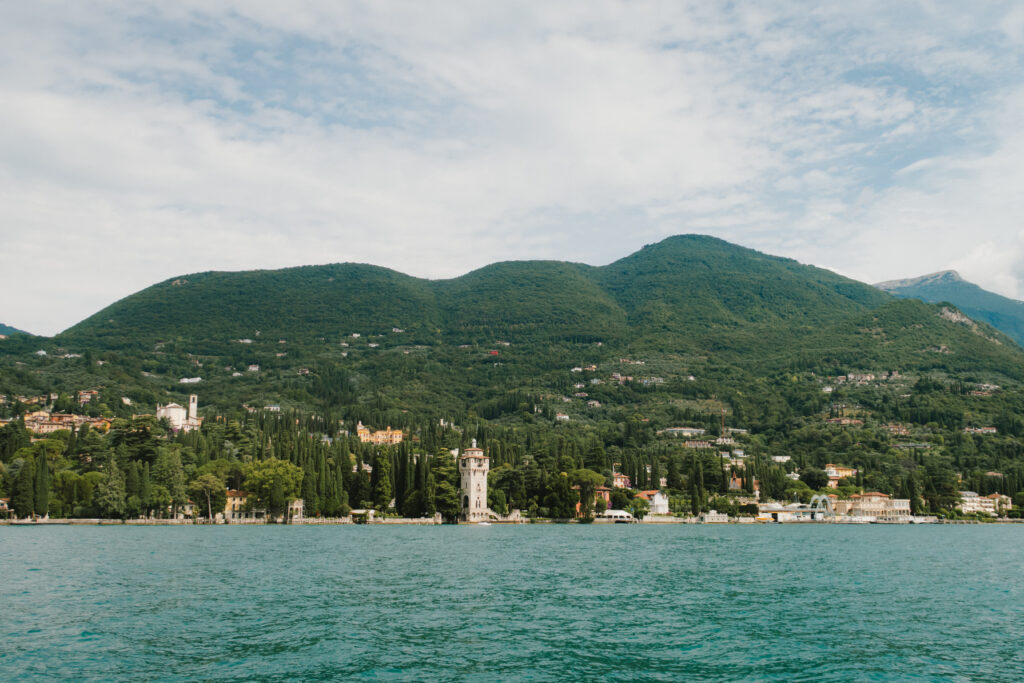
You’ve heard of Lake Como, but have you heard of Lake Garda? If you’re dreaming of a place where sparkling waters meet pastel villages, ancient castles perch on hilltops, and gelato is a daily ritual—Lake Garda should be at the top of your travel list. Italy’s largest lake is a destination that blends relaxation and adventure, romance and culture, and a whole lot of jaw-dropping scenery. Whether you’re here for hiking, swimming, boating, wine-tasting, or just soaking up that dolce vita energy, Lake Garda offers something for every kind of traveler. I loved that it was less crowded than the popular Lake Como—there were still tourists, but they were all European. We didn’t run into a single American during our week there.
Things to do on Lake GardaTake a boat tour:
- Take a boat tour: Hop between towns or rent a private boat for a leisurely lake day.
- Lake activities: Find a quiet cove or beach club and dive in—especially in July and August. If you’re feeling more adventurous, try paragliding over the lake, kite surfing, or sailing.
- Go wine tasting: The Bardolino wine region offers amazing local wines and beautiful hilltop, lakeside views.
- Ride the cable car to Monte Baldo: Sweeping alpine and lake views, with trails for all levels.
- Explore by bike: Rent an e-bike to cruise along the lake’s scenic cycling paths.
Top Must-Visit Towns:
Lake Garda (Lago di Garda) straddles three Italian regions—Lombardy, Trentino-Alto Adige, and Veneto—each offering its own unique vibe. The northern shore is framed by dramatic mountains and attracts outdoor adventurers, while the southern towns are flatter, sun-drenched, and rich with history, vineyards, and charming old towns. It’s a place where you can hike in the morning, sail in the afternoon, and sip wine on a terrace by the sunset. Here are the top towns I recommend visiting:
Sirmione
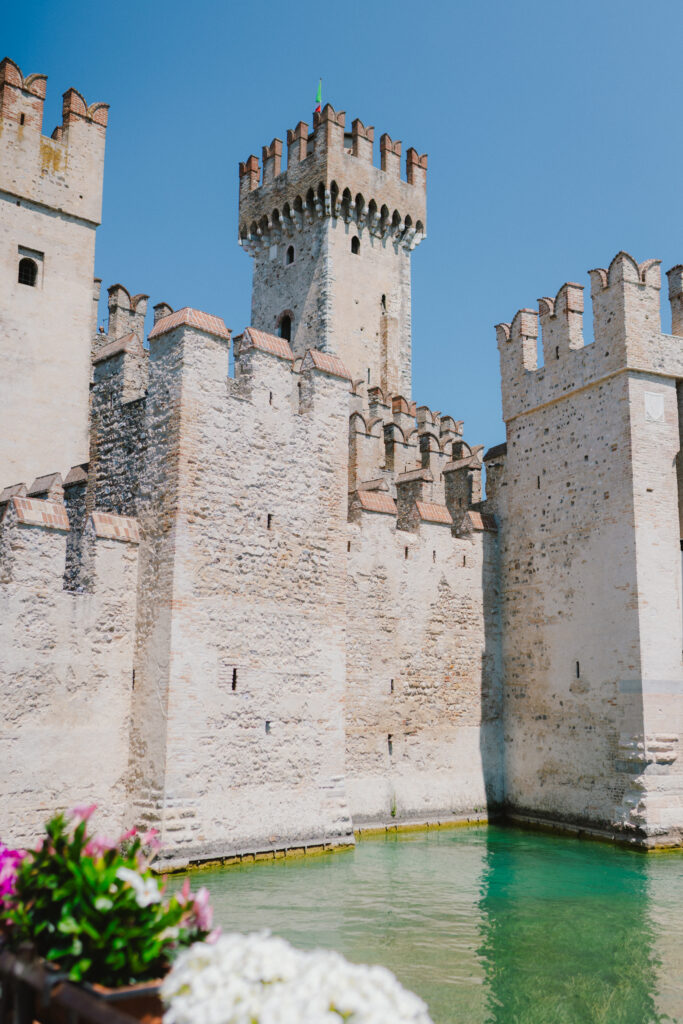
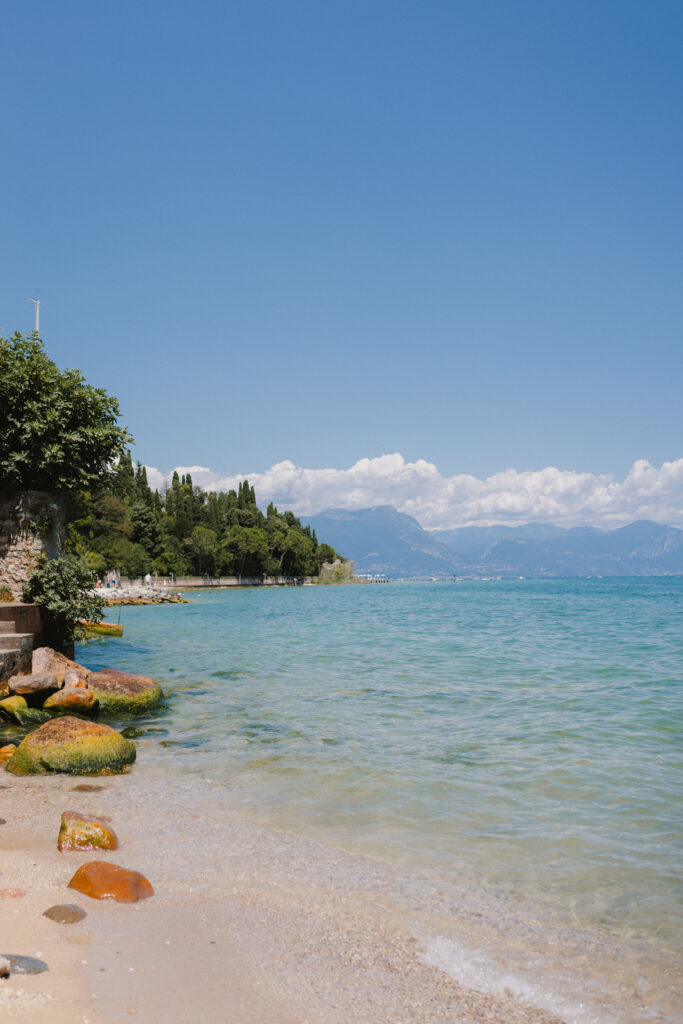
Known as the “Pearl of the Lake,” this picturesque town is perched on a narrow peninsula jutting into the southern end of the lake.
Highlights include:
- Scaliger Castle: A fairytale-like fortress with lake views.
- Grotte di Catullo: Ruins of an ancient Roman villa overlooking the water.
- Thermal spas: Treat yourself at Aquaria Thermal Spa for the ultimate lakeside relaxation.
STAY:
Villa Cortine Palace
📍Location: Sirmione
The Villa Cortine Palace Hotel is a luxurious 5-star, 1 Michelin Key retreat set upon a hill in the heart of the peninsula of Sirmione in a lush private park with impressive statues and fountains overlooking Lake Garda. Housed in a stately neoclassical villa, it features opulent interiors, elegant guest rooms, and stunning gardens dotted with fountains and sculptures. With a private lakeside pier, tennis courts, and refined dining, it offers a secluded, romantic escape just steps from Sirmione’s historic center.
Malcesine
On the eastern shore, Malcesine is a storybook village with cobblestone alleys and a vibrant harbor.
- Monte Baldo Cable Car: Ride to the top for epic views and great hiking.
- Scaliger Castle (yes, another one!): With a museum and panoramic views from the tower.
- Water activities: Windsurfing, kayaking, and boat tours.
Limone sul Garda
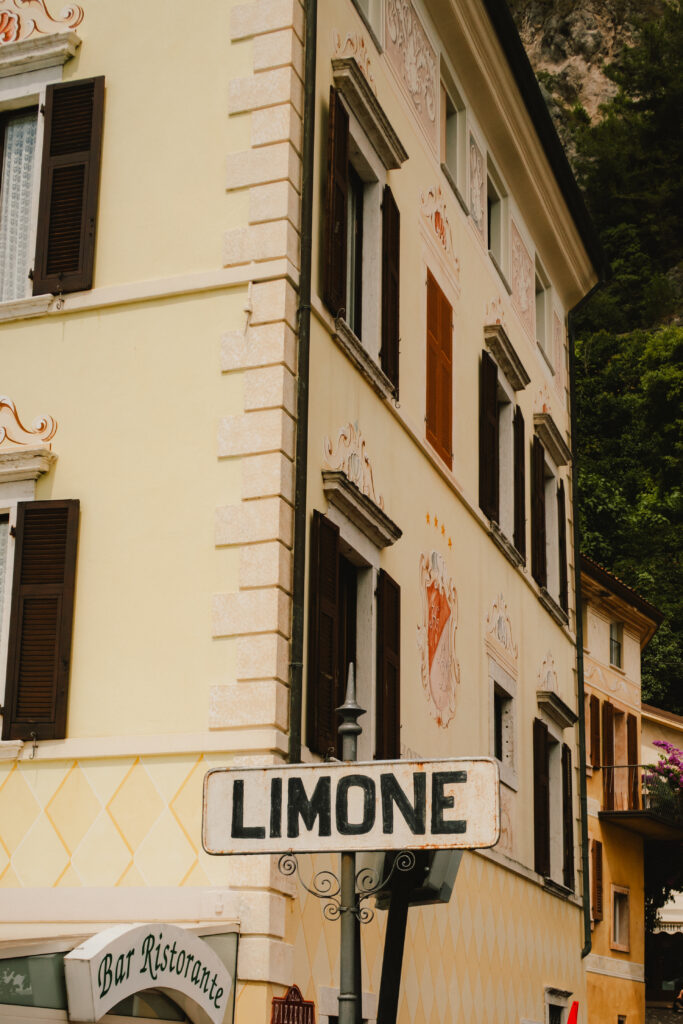
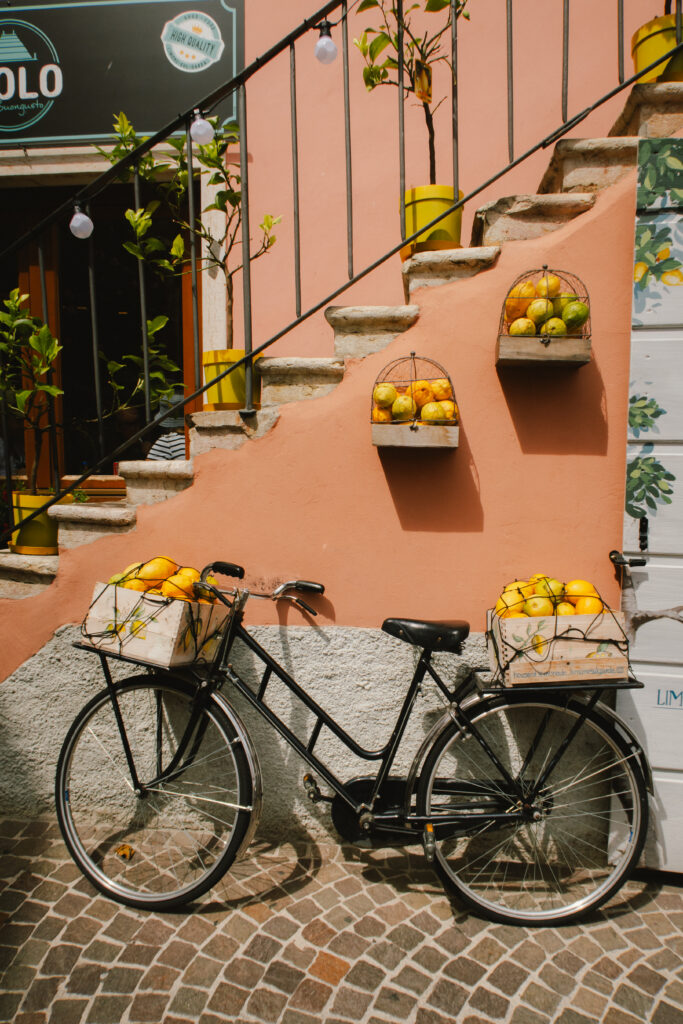
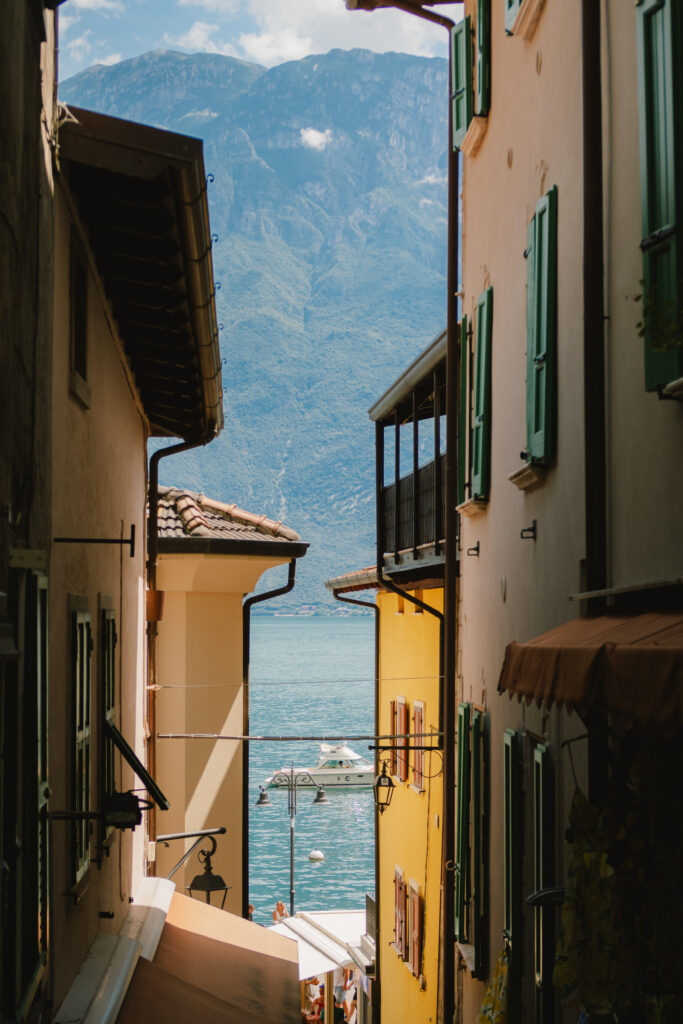
This lemon-themed town reminiscent of Positano is on the northwest shore and is famous for its citrus groves and pastel buildings that cling to the cliffs.
- Limonaia del Castel: A historic lemon house turned museum.
- Lakeside promenades: Perfect for golden hour walks while eating their famous lemon sorbet.
- Scenic cycle path: The cliff-hugging path offers incredible lake views.
Riva del Garda
Located at the very northern tip of the lake, Riva is surrounded by alpine peaks and is ideal for nature lovers.
- Hiking and biking: Trails to waterfalls, castles, and scenic overlooks.
- Sailing and windsurfing: The wind conditions here are legendary.
- Old Town: Colorful streets, cozy cafés, and great shopping.
Bardolino
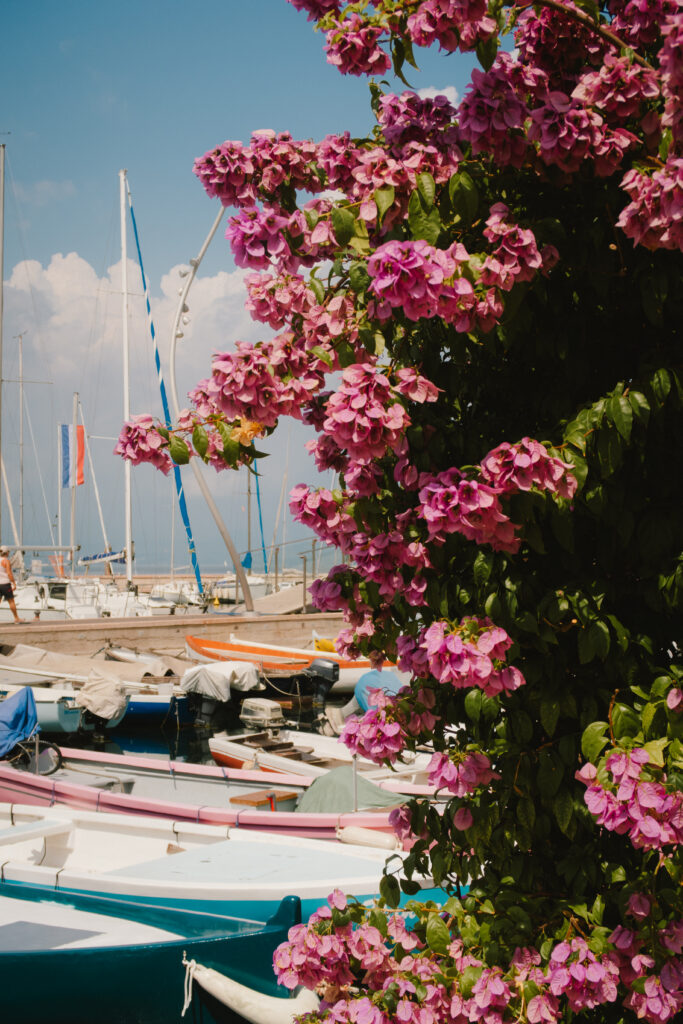
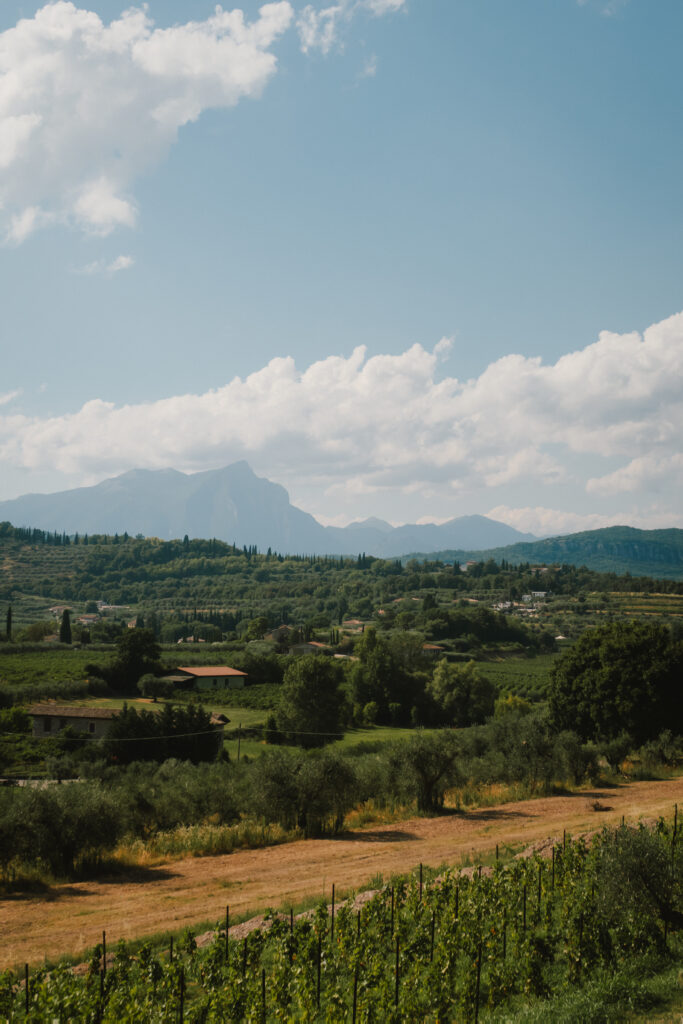
Nestled on the southeastern shore, Bardolino is known for its vibrant promenade, relaxed atmosphere, and, of course, its famous Bardolino red wine. Surrounded by vineyards and olive groves, it’s a dream destination for food and wine lovers.
- Bardolino wine route: Visit nearby wineries for tastings and local delicacies.
- Lakefront walks: One of the prettiest promenades on the lake—perfect for sunset strolls or morning jogs.
- Olive Oil Museum: A surprisingly interesting stop just outside town.
- Weekly market: Great for shopping, food stalls, and local crafts.
STAY:
Palace Hotel San Pietro
📍Location: Bardolino
4-Star Palace Hotel San Pietro Bardolino is a charming lakeside hotel located on the shores of Lake Garda, offering stunning views and elegant accommodations. Guests can relax in comfortable rooms and suites, enjoy local cuisine at the on-site rooftop restaurant, and unwind in the hotel’s wellness and leisure facilities. The hotel provides easy access to Bardolino’s historic center, vineyards, and lakeside promenade, making it ideal for both relaxation and exploration. This is a great budget friendly option!
Gardone Riviera
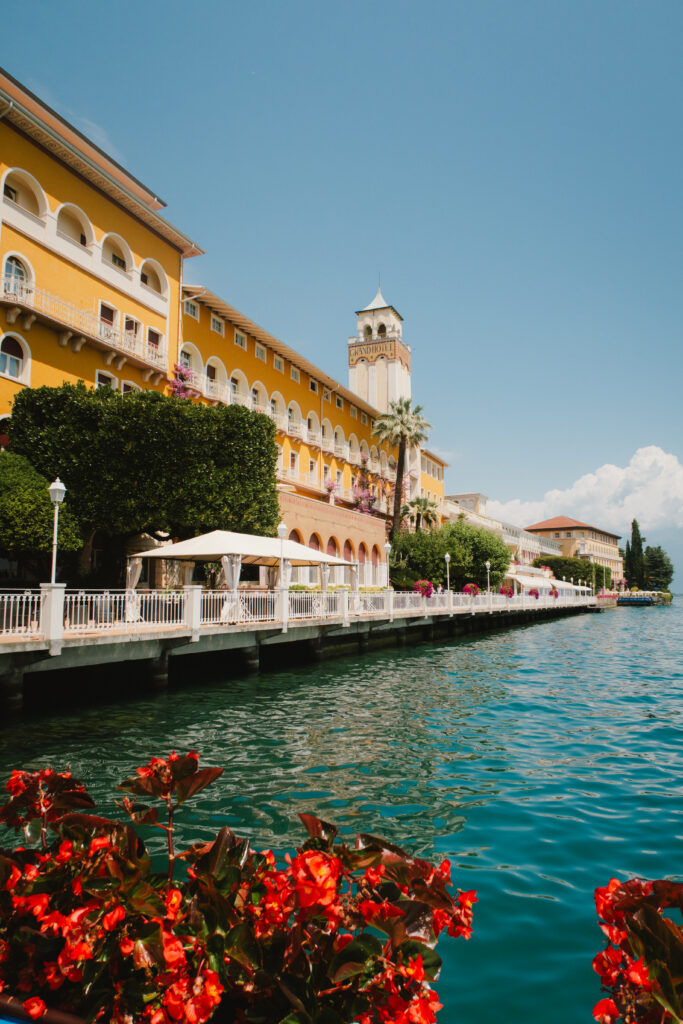
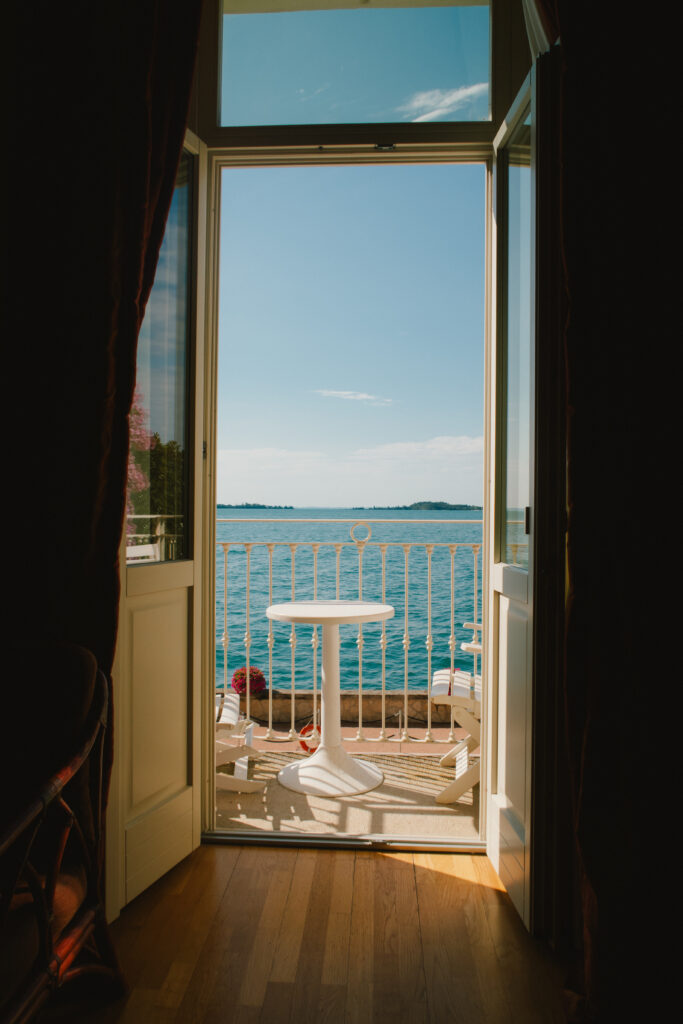
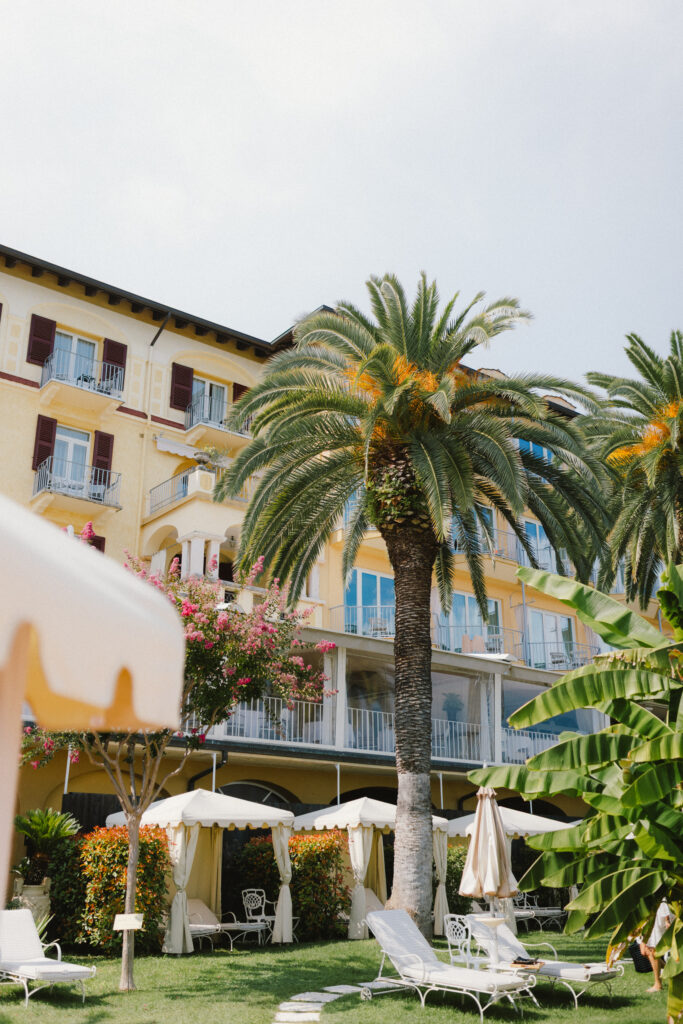
If you’re looking for elegance and a touch of old-world charm, Gardone Riviera is a refined and peaceful spot on Lake Garda’s western shore. It was once a haven for artists and aristocrats, and it still carries that grand, timeless feel.
- Botanical Garden (Heller Garden): An enchanting oasis of exotic plants, modern sculptures, and serene walking paths.
- Fine dining: Gardone is known for upscale Michelin-starred restaurants and lakeside cafes.
- Quiet luxury: Ideal for romantic getaways or wellness weekends with several luxury hotels to choose from.
STAY:
Grand Hotel Gardone
📍Location: Gardone Riviera
The 4-star Grand Hotel Gardone is an iconic 19th-century hotel set along the waterfront in Gardone Riviera on Lake Garda. Known for its classic elegance, it offers spacious rooms—many with balconies overlooking the lake—alongside a lakeside pool, private pier, and fine dining terrace. Its rich history and old-world charm, paired with modern comforts, make it a favorite for travelers seeking a timeless Lake Garda experience without breaking the bank.
Grand Hotel Fasano
📍Location: Gardone Riviera
The Grand Hotel Fasano is a historic five-star retreat on Lake Garda’s tranquil western shore in Gardone Riviera. Once an Austrian imperial hunting lodge, it blends Belle Époque elegance with modern luxury, surrounded by lush gardens and direct lake access. Guests enjoy refined rooms and suites—many with sweeping lake views—Michelin-starred dining, and the expansive AQVA Spa, making it a perfect escape for romance, relaxation, and lakeside exploration. (Book with me and get free perks like potential room upgrade, early check-in/late check-out, complimentary breakfast, and $100 resort credit- reach out to merissa.bradford@fora.travel)
Places to eat & drink on Lake Garda:
- Biri Bardolino: One of Bardolino’s top spots for foodies seeking a modern twist on Italian classics. The restaurant’s philosophy centers around seasonal ingredients, minimalist presentation, and bold flavor combinations. Expect dishes like homemade pasta with lake fish and citrus, veal with truffle cream, or local vegetables reimagined as gourmet starters.
- Hostaria al Buongusto in Limone: The kind of place you hope to stumble upon in Italy, this is a family-run restaurant where the food is honest, the service is kind, and the portions are generous. The menu features classic northern Italian and Veneto dishes, with rich flavors and rustic presentation—think slow-cooked beef in Amarone wine, fresh pasta with porcini mushrooms, and homemade tiramisu. Set in a courtyard with wisteria hanging from above, it is a scenic yet authentic spot.
- Il Fiore di Zucca: Tucked away in the hills of Gardone Riviera, this restaurant stands out for its dedicated gluten-free options and inventive menu. From gluten-free pizza and homemade pasta to seasonal vegetarian specials, the kitchen accommodates dietary needs without sacrificing flavor or quality. The staff is incredibly attentive and knowledgeable about allergens, making it a great choice for travelers with food sensitivities.
- Vecchia Malcesine: A Michelin-starred restaurant that is a true gem, perched above the lake in one of the prettiest towns. Chef Leandro Luppi creates bold, contemporary dishes with lake fish, herbs, and seasonal ingredients, all plated with artistic finesse. The tasting menu plays with textures and unexpected flavors while still feeling grounded in the region.
- Lido 84 in Gardone Riviera: Often considered one of Italy’s most exciting restaurants, Lido 84 has become a destination in itself. With a stunning lakeside setting and wildly inventive tasting menus, Chef Riccardo Camanini takes Italian tradition and gives it a modern, unexpected twist.
- Villa Feltrinelli: A two-Michelin-star restaurant. Housed in a grand 19th-century villa, surrounded by manicured gardens and overlooking the lake, it’s the definition of lakeside luxury. Chef Baiocco’s cuisine is elegant and delicate, using rare herbs and vegetables grown on-site. The experience is theatrical and timeless—more like dining in a living postcard.
Tips for Visiting Lake Garda:
- Best time to visit: Late May to early October for sunny days and warm water. Avoid August if you want to skip the peak crowds.
- Getting there: The nearest airports are Verona, Bergamo, and Milan. Renting a car is the best way to explore the whole lake.
- Getting around: Car, ferry, or bicycle. Ferries connect most towns and are a scenic way to travel.
- What to pack: Swimsuits, comfortable walking shoes, sun protection, and a light jacket for breezy evenings.
Dolomites:
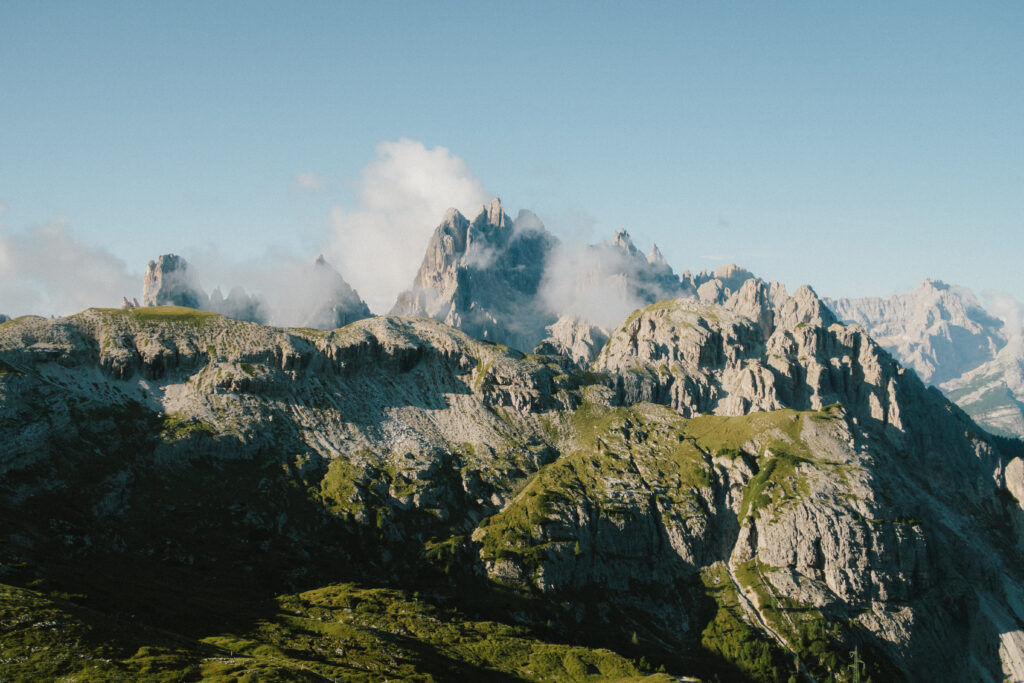
After a week in Lake Garda, we rented a car and drove up to the Dolomites (around 2 hour drive depending where you’re coming from). The Dolomites had been on my bucket list for so long, and I finally got to experience it for myself. The photos truly don’t do it justice, and seeing the region with your own eyes is an absolute must. We spent a full week exploring the area while also relaxing at some amazing hotels.
What To Do In The Dolomites:
The Dolomites span a vast and diverse region, making it challenging to decide exactly what to see—especially if you’re short on time. If you’re visiting during the peak summer season, it’s essential to start your days as early as possible. Not only will you beat the crowds, but you’ll also avoid the frustration of full parking lots and long lines at popular spots. Early mornings in the Dolomites often come with crisp air, golden light, and a peacefulness that disappears by midday.
Here are my top recommendations for unforgettable places to visit and explore:
Lago di Braies: This picture-perfect lake is easily one of the most photographed spots in the Dolomites, and for good reason. The water shimmers in shades of turquoise and emerald, set against a dramatic backdrop of towering peaks and pine forests. It’s a magical place that feels almost unreal. Don’t miss the chance to walk the loop trail around the lake or rent a traditional wooden boat for a unique perspective.
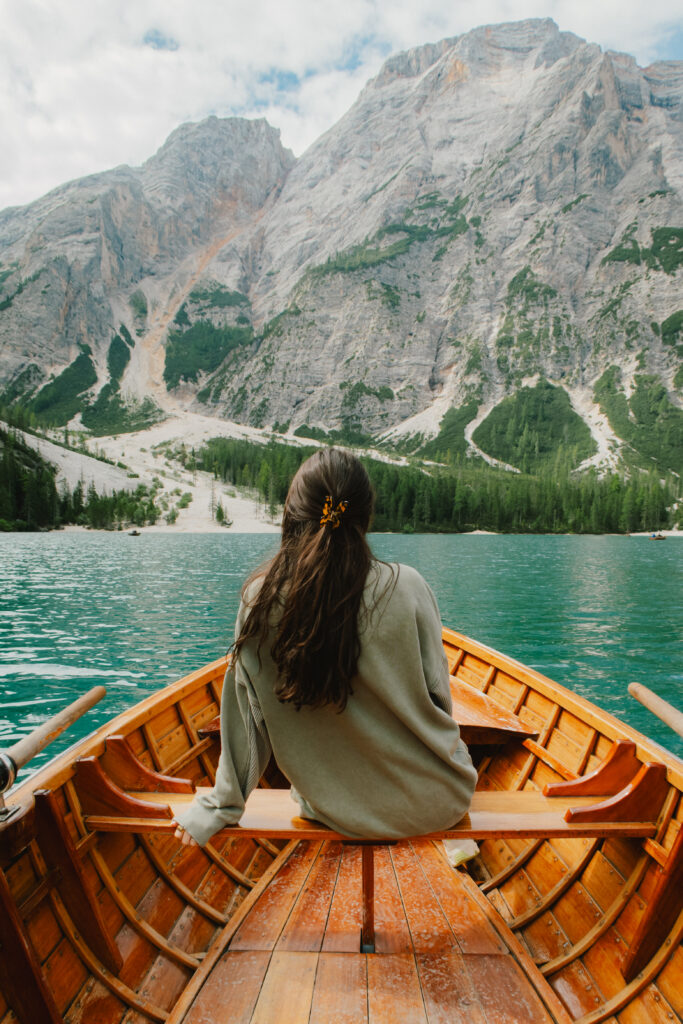
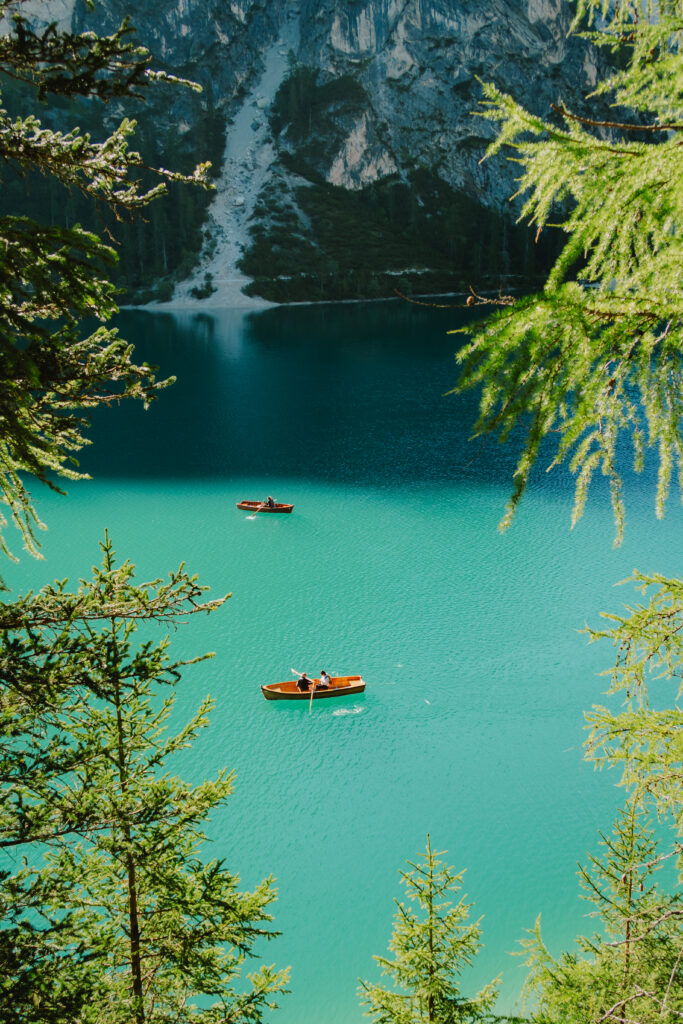
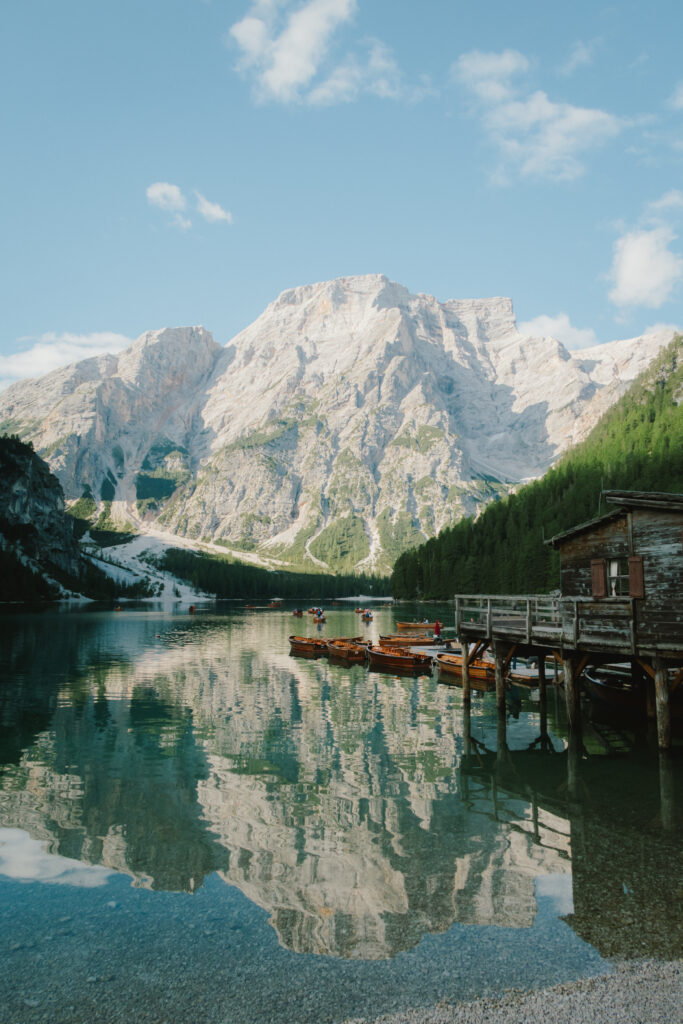
Cadini di Misurina: This hike is a true hidden gem that feels like walking through a fantasy world. The jagged, spire-like peaks are mesmerizing, and the trail offers several jaw-dropping viewpoints along the way. It’s not overly long or difficult, but the payoff is extraordinary. A must for photographers and nature lovers alike.
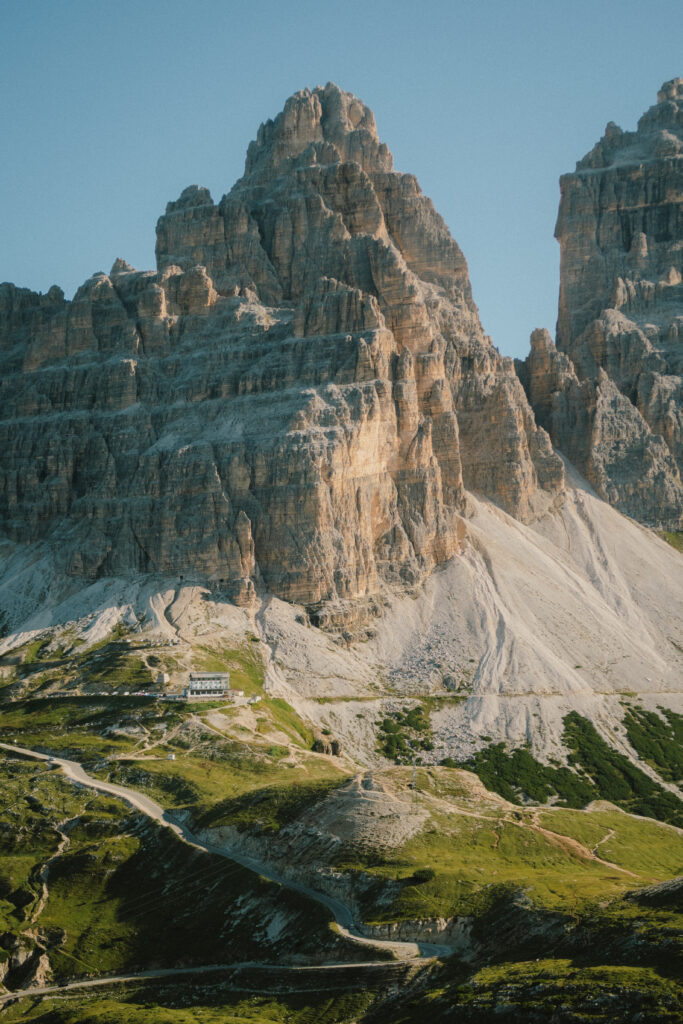
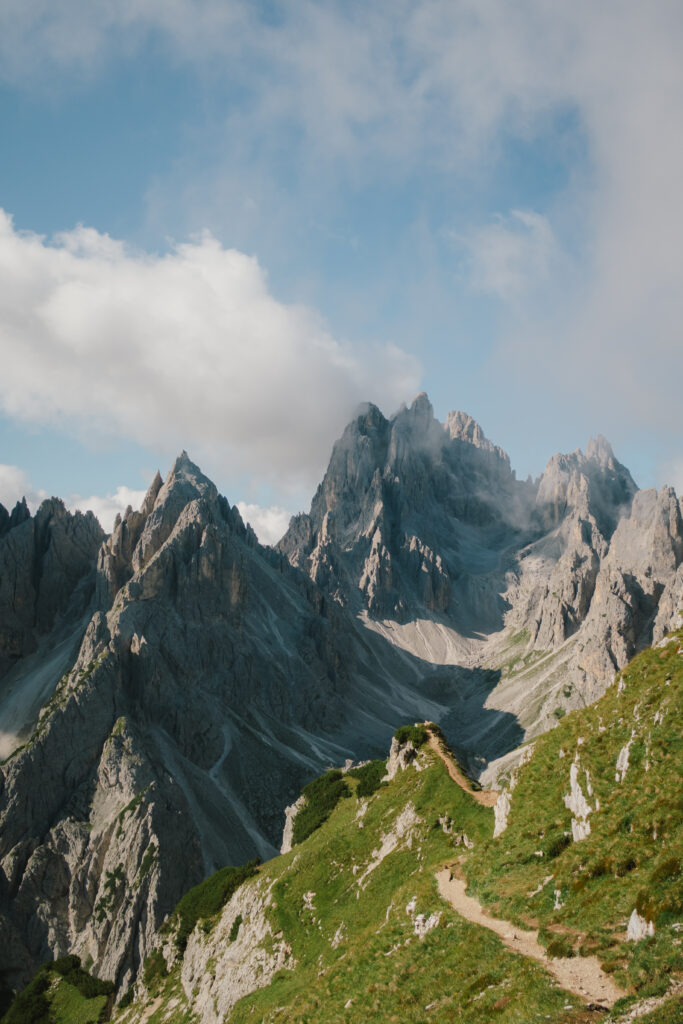
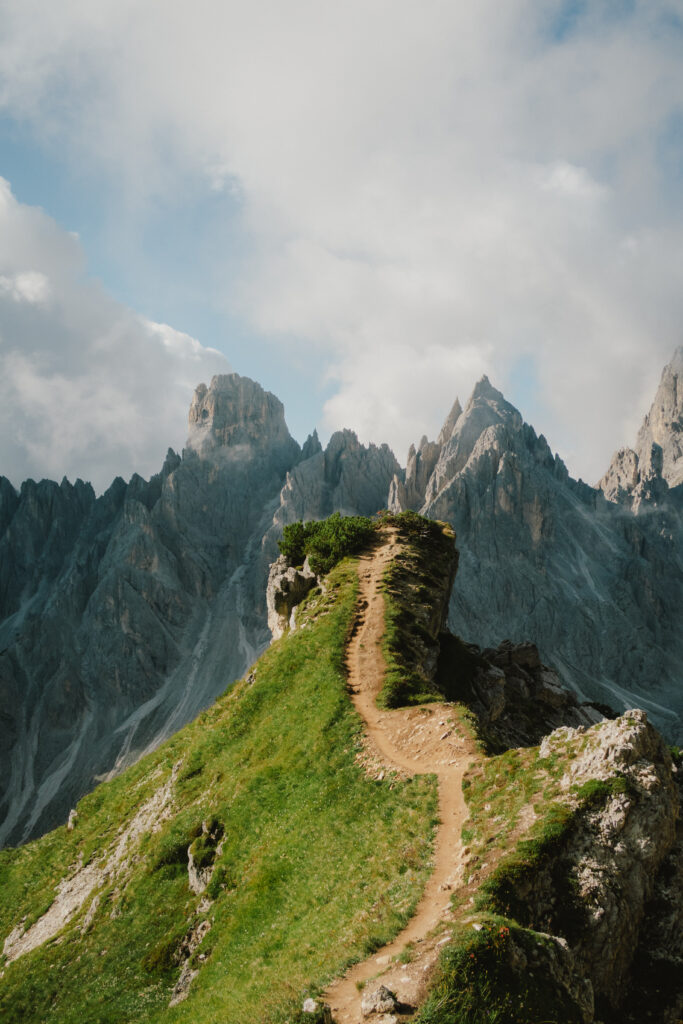
Tre Cime di Lavaredo: One of the most iconic hikes in all of Italy, Tre Cime features three towering peaks that define the Dolomites skyline. The trailhead starts from the same parking lot as Cadini di Misurina, so you can easily do both in one adventurous day. The loop around the peaks offers sweeping alpine vistas, charming rifugi (mountain huts), and countless photo ops.
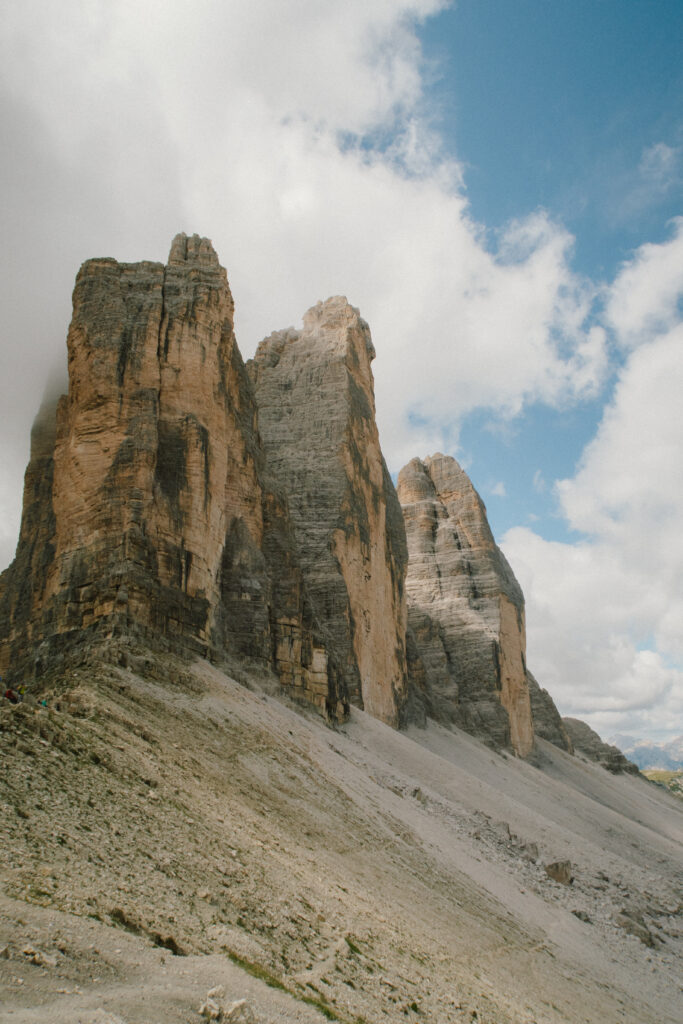
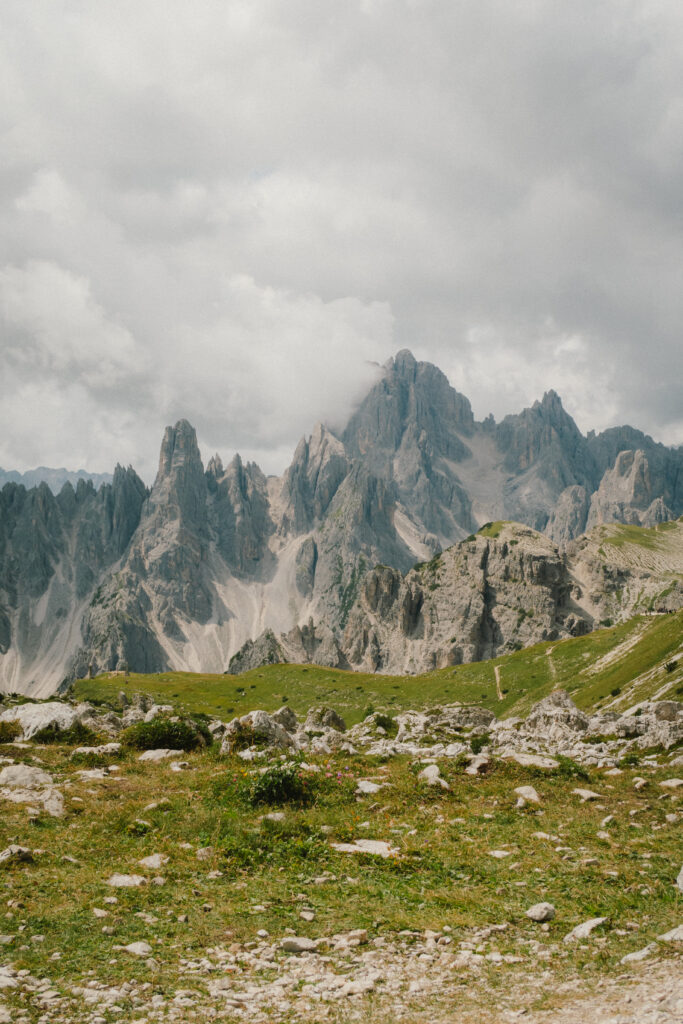
Seceda: Located in the heart of the Dolomites, it’s famous for its dramatic, jagged peaks and panoramic alpine views that are truly unforgettable. Accessible by cable car, it offers scenic hiking trails, ski slopes in winter, and endless photo opportunities year-round. The unique landscape, with its striking ridges and green meadows, makes Seceda a must-visit destination for nature lovers, adventure seekers, and photographers alike.
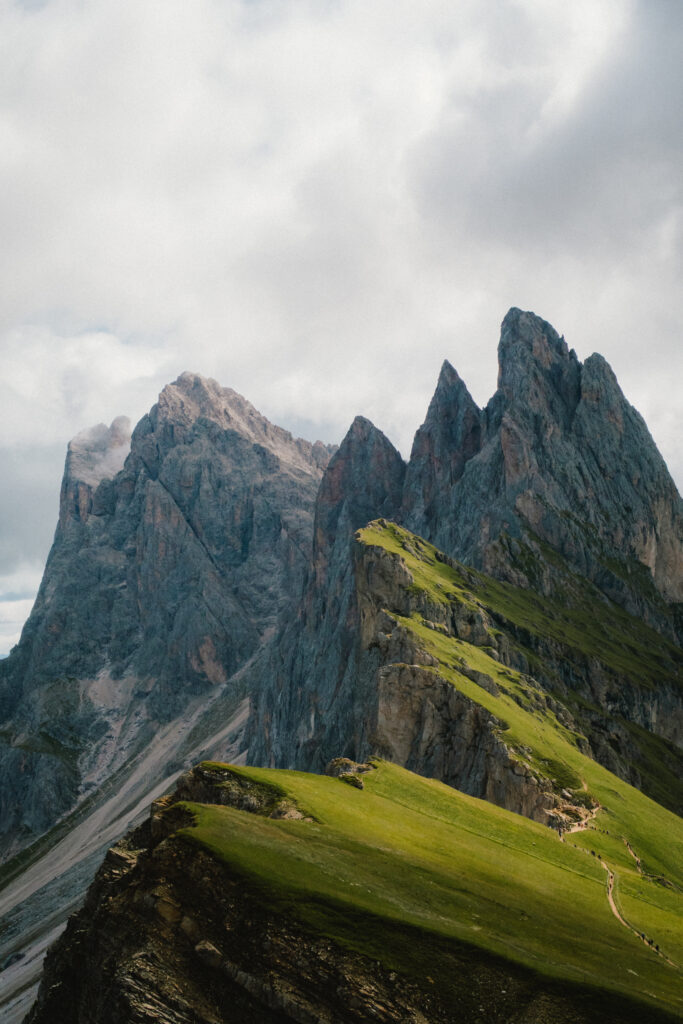
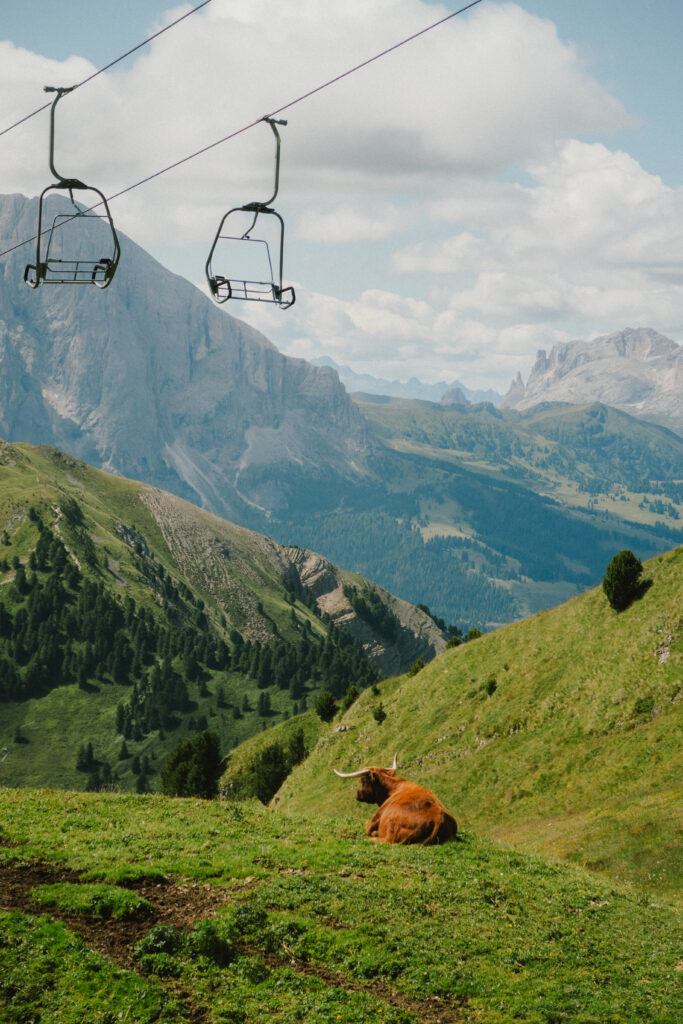
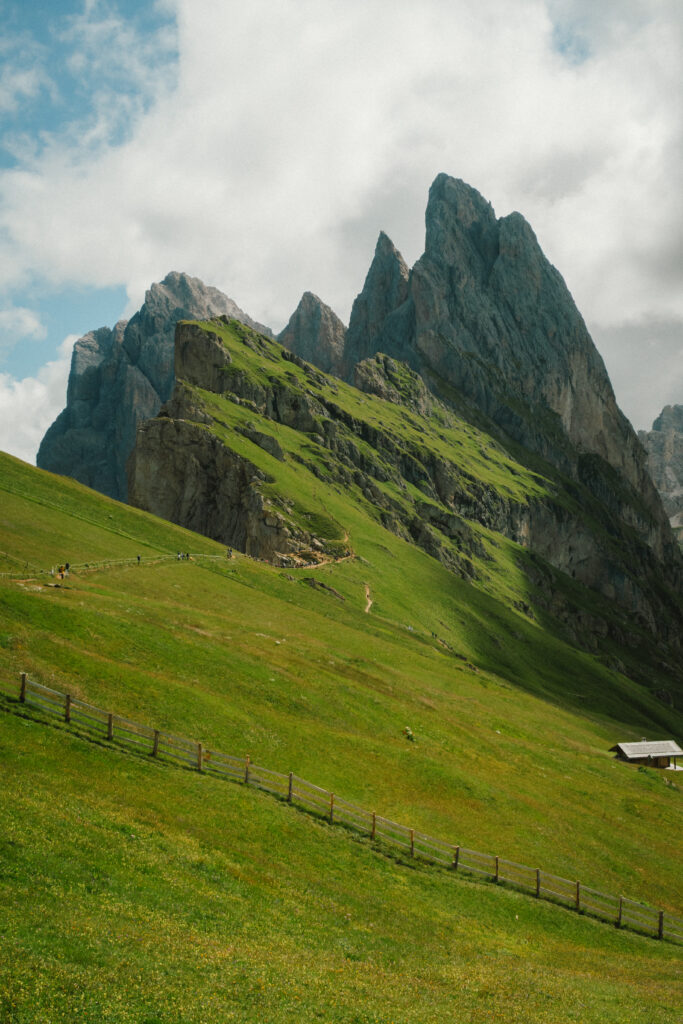
Val di Funes: This serene and picturesque valley is a postcard come to life. With rolling green meadows, quaint alpine farms, and the dramatic Odle mountain group as a backdrop, it’s hard to take a bad photo here. Don’t miss the historic churches of San Giovanni and Santa Maddalena—they’re small but incredibly scenic, especially at sunrise or sunset.
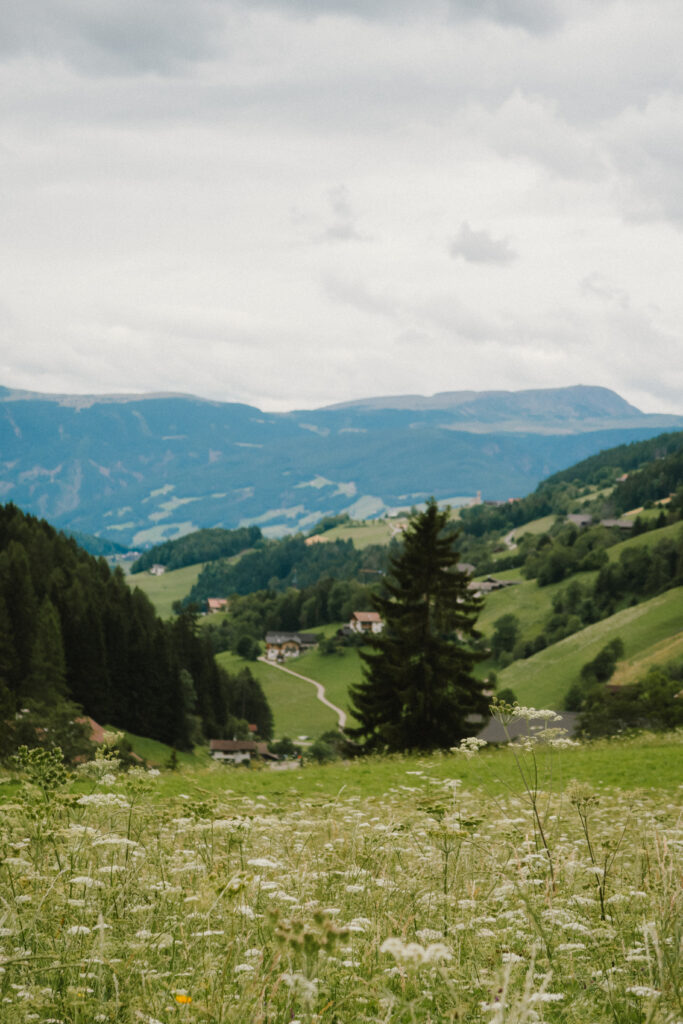
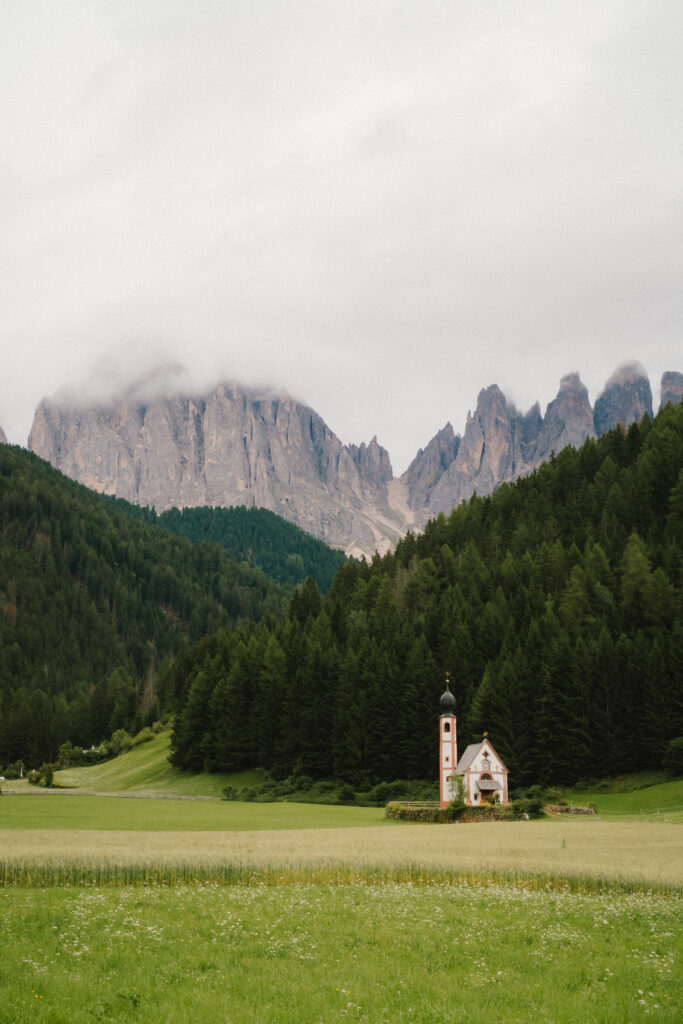
Alpe di Siusi (Seiser Alm): The largest alpine meadow in Europe, this high-altitude plateau is known for its wide-open landscapes, blooming wildflowers, and breathtaking views. It’s the perfect place for a relaxing walk, a scenic bike ride, or even a peaceful picnic. The sense of space and calm here is unmatched, and the panoramas go on for miles.
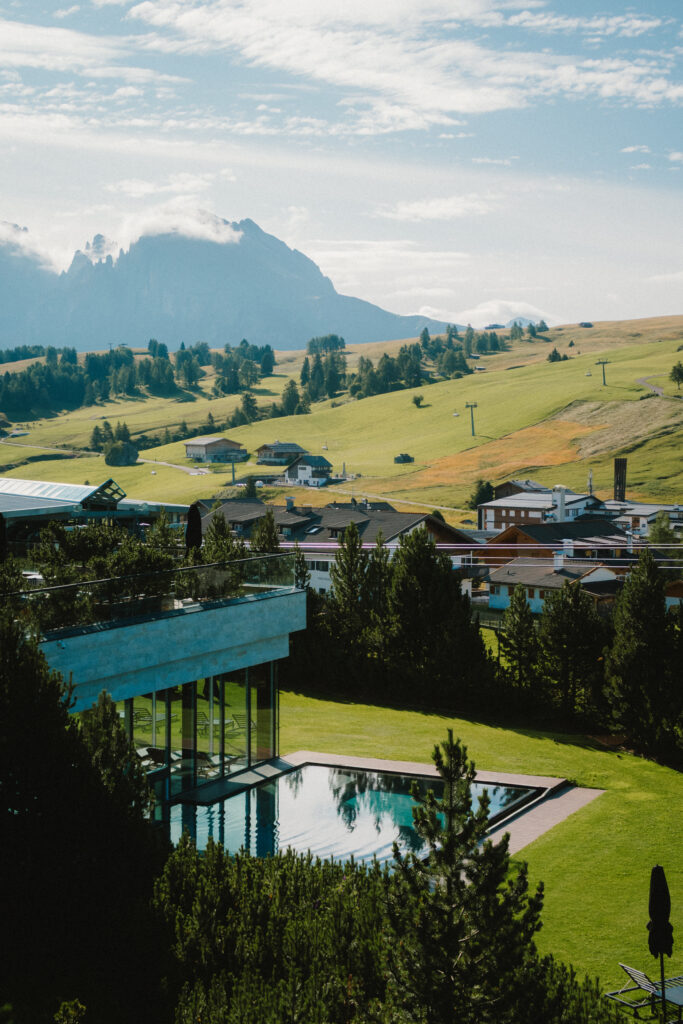
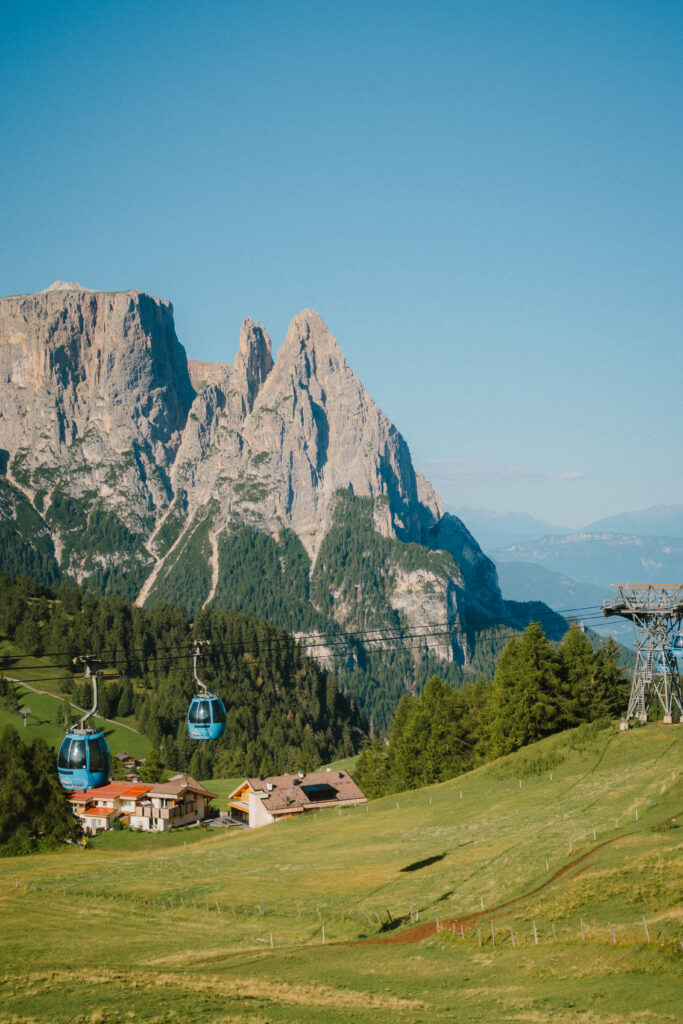
After your days of hiking, you can relax back at your hotel spa or pool and take in the views.
Where To Stay:
Choosing where to stay in the Dolomites is the hardest part of planning your trip! The must-visit spots are all very spread out, so it’s important to plan your stays accordingly. Here are some of the luxury hotels I recommend in the Dolomites that I stayed at and thoroughly enjoyed!
Forestis Dolomites
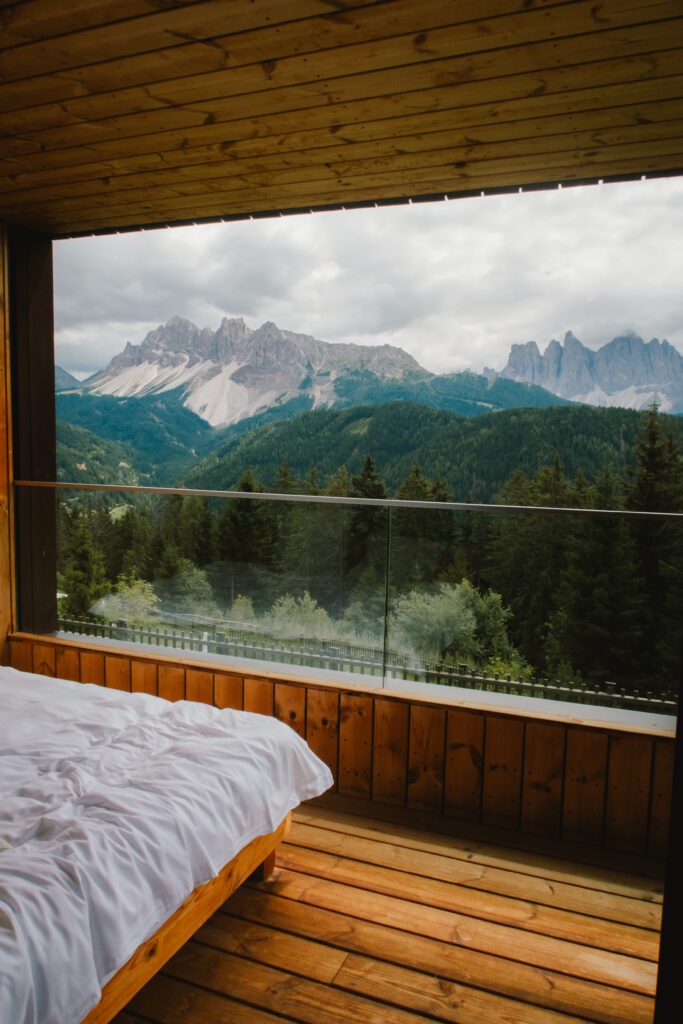
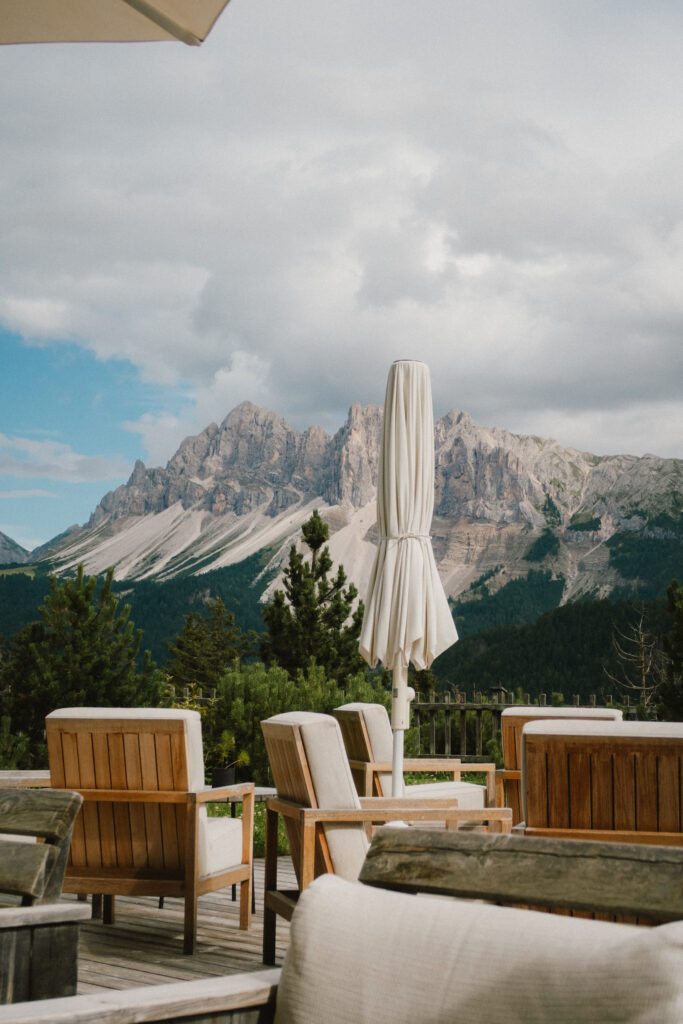
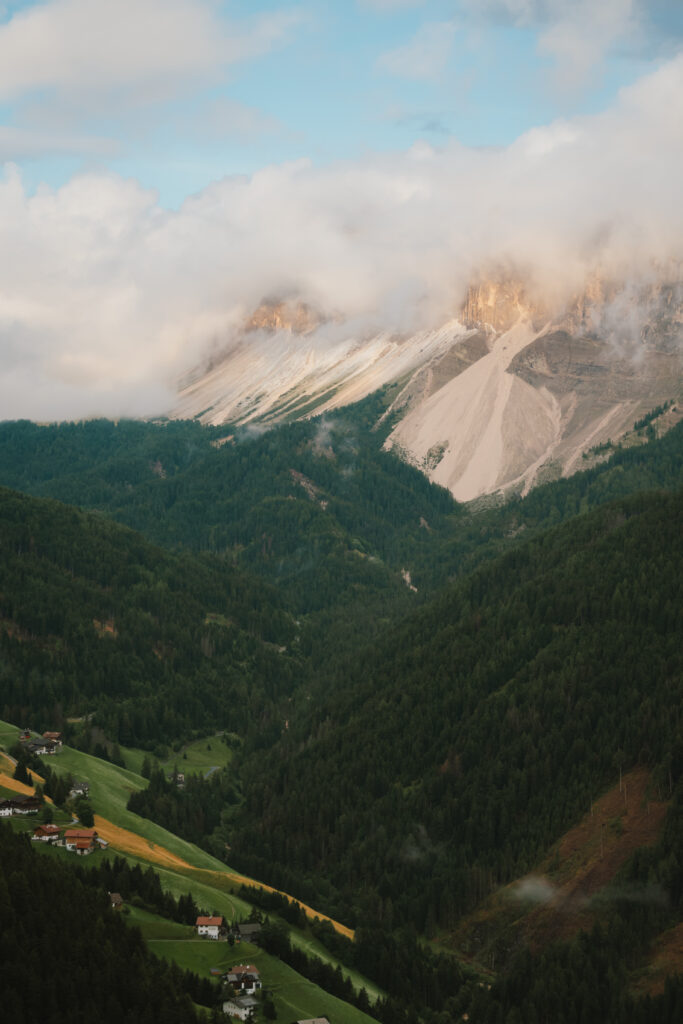
📍Location: Brixen/Bressanone
Tucked high above the forested slopes of Plose, Forestis is a sanctuary of calm and quiet sophistication. This adults-only, 5 star and 2 Michelin Key eco-conscious hideaway blends minimalist architecture with panoramic views of the Dolomites from every suite. Everything here is rooted in nature—from the locally sourced materials to the seasonal cuisine and holistic spa treatments inspired by the forest’s energy. The 7-course tasting dinners (available to guests only) change daily and focus on foraged and regional ingredients.
COMO Alpina Dolomites
📍Location: Alpe di Siusi (Seiser Alm)
Perched on the high-altitude plateau of Alpe di Siusi, 5 star and 1 Michelin Key COMO Alpina Dolomites is a stunning blend of contemporary architecture and warm alpine hospitality. Open year-round, it caters to both summer hikers and winter skiers with ski-in/ski-out access. Expect COMO’s signature wellness philosophy: an expansive spa, yoga and Pilates offerings, and healthy but indulgent cuisine. Interiors are stylish and calming, with natural stone, wood, and panoramic views throughout.
Hotel de Len
📍Location: Cortina d’Ampezzo
4 Star Hotel de Len brings a fresh, eco-luxury feel to the heart of Cortina d’Ampezzo. Owned by Egnazia Group (Borgo Egnazia), its name means “House of Wood,” and the interiors are crafted entirely from locally sourced materials, down to the larch and fir beams from nearby forests. Rooms are minimalist but cozy, with thoughtful design and wellness details like sound-absorbing walls and custom-made beds. The rooftop spa features an infrared sauna and hot tub with a view, while the in-house restaurant (on the Michelin guide) celebrates regional flavors with a modern twist throughout.
Dining in The Dolomites:
The Dolomites are known for their jaw-dropping scenery, but the culinary experiences here are just as unforgettable. Blending Austrian, Tyrolean, and Italian influences, the food in this region is hearty, seasonal, and deeply connected to the land. Whether you’re dining at a sleek Michelin-starred restaurant or enjoying a rustic hut meal with views for days, each spot offers its own unique charm.
- Forestis (elevated forest-to-table fine dining): If you’re staying at Forestis, you’re in for a truly exceptional culinary experience. Dinner is exclusively available to overnight guests, but it’s absolutely worth opting for the half-board package, which includes a seven-course tasting menu each evening. The dishes change nightly and are inspired entirely by the surrounding forest—think wild herbs, locally foraged mushrooms, game meats, and alpine roots reimagined into artful, contemporary plates. Everything is seasonal, sustainable, and beautifully presented.
- Alpina Chalet (cozy, authentic alpine cuisine): Located in the heart of Alpe di Siusi, Alpina Chalet offers traditional South Tyrolean comfort food with a warm, rustic vibe. Think handmade dumplings, rich polenta dishes, tender venison, and homemade desserts like apple strudel and Kaiserschmarrn. It’s the kind of place where you can linger after a day of hiking, glass of wine in hand, watching the light change on the peaks outside. During ski season, it’s a popular après-ski spot right on the slopes with a DJ.
- Baita Sofie Hütte (lunch with a view): At over 2,400 meters above sea level, Baita Sofie Hütte isn’t just a restaurant—it’s a full-on mountaintop experience. Located above the Seceda ridgeline, it’s the perfect lunch spot after a morning of hiking or skiing. The food here is hearty and traditional, featuring mountain favorites like goulash, dumplings, and grilled sausages, paired with Tyrolean wines and panoramic views that will stop you in your tracks.
- Restaurant de Len (modern mountain dining): For a more modern take on Dolomites cuisine, Restaurant de Len in Cortina d’Ampezzo blends upscale alpine design with creative farm-to-table dishes. This Michelin Guide menu is seasonal and refined, featuring locally sourced meats, fresh pastas, and regional produce presented with artistic flair. It’s ideal for a special dinner out or a relaxed but elevated dining experience after a day of exploring Cortina’s charming town center.
- Restaurant Pizzeria Al Passetto (casual pizza joint in Cortina d’Ampezzo): If you’re gluten-free, Al Passetto is a hidden gem that caters beautifully to celiac and gluten-sensitive travelers. Located in Cortina, this casual and welcoming spot serves up celiac-safe pizza with crispy thin crusts and all the traditional toppings you’d expect—from wood-fired margherita to rich truffle and mushroom combos. They take cross-contamination seriously, so you can dine here with confidence while still enjoying that classic Italian pizza experience. They also serve normal pastas and pizzas, so there’s something for everyone!
Tips for Visiting The Dolomites:
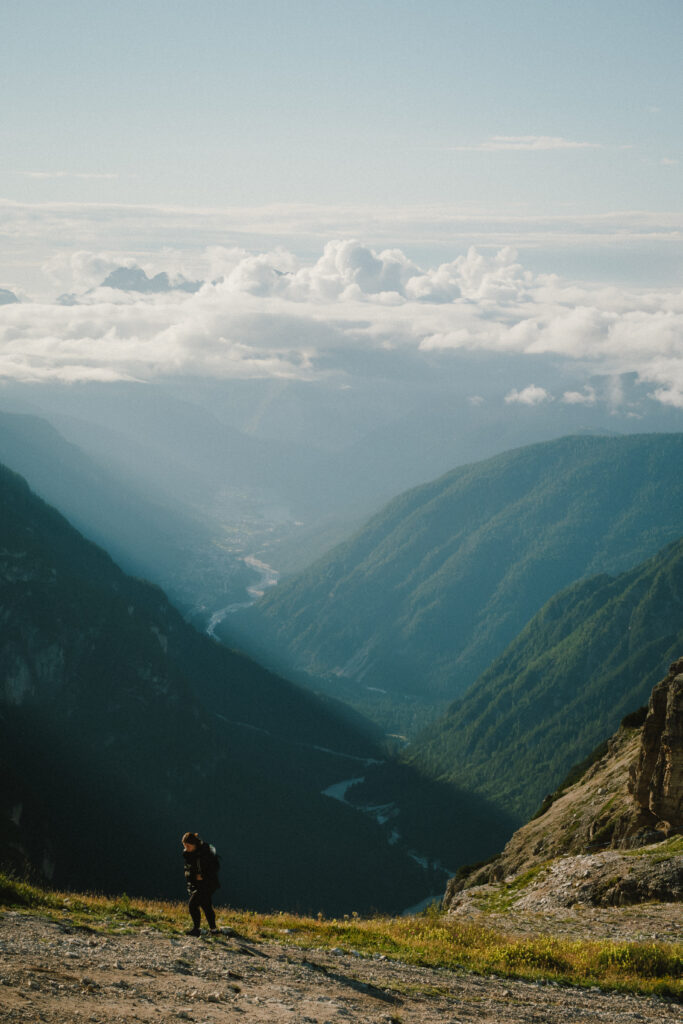
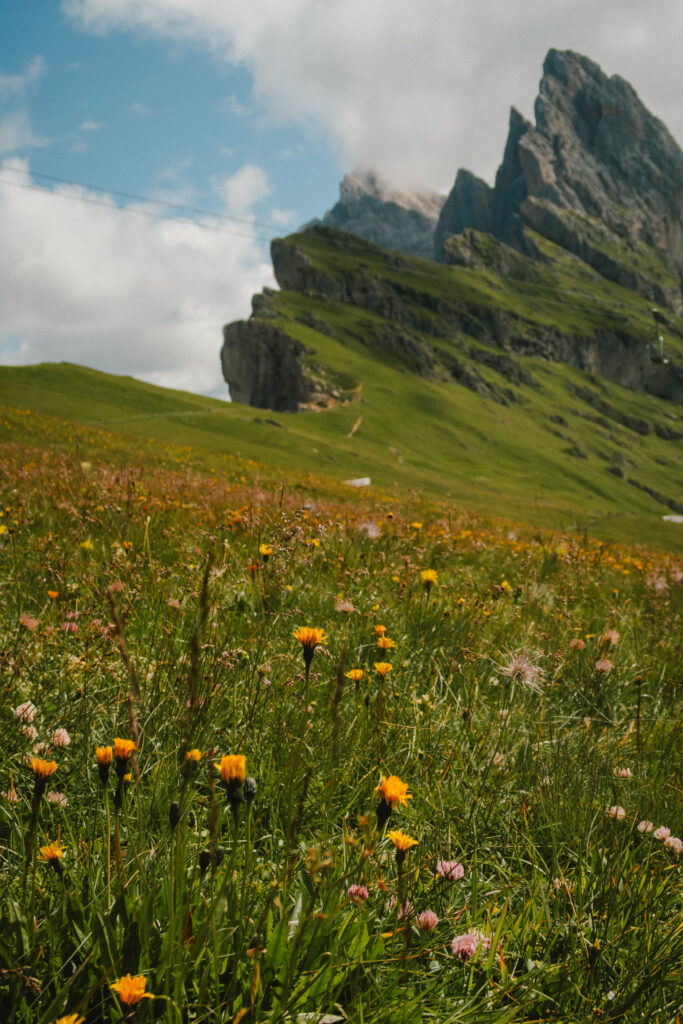
Exploring the Dolomites is an unforgettable experience, but a bit of planning goes a long way in making your trip smoother, safer, and more rewarding. Whether you’re visiting for the hiking, photography, skiing, or just the scenery, here are some key things to know before you go.
When to visit
- Summer (June–September): Best for hiking, biking, and outdoor exploration. Expect warm days, cool nights, and occasional afternoon storms. July and August are peak seasons—stunning, but crowded.
- Autumn (late September–mid-October): The golden larches and quieter trails make this a dream for photographers and peaceful nature lovers. Some hiking trails may close down for snow/ice.
- Winter (December–March): The Dolomites transform into a world-class ski destination. Think cozy mountain lodges, snow-covered villages, and legendary ski runs. The 2026 Winter Olympics will be hosted here!
- Spring (April–May): Less ideal, as many trails, hotels, and lifts are still closed. Snowmelt can make hiking unpredictable.
Hiking tips
- Start early: Parking lots fill up quickly, especially at Lago di Braies, Seceda, and Tre Cime. Arrive before 8 am if possible.
- Check conditions: Weather can change fast in the mountains. Always check forecasts before heading out, and be prepared to turn back if needed.
- Know your trails: Many hikes are family-friendly, but others require gear and experience. Don’t underestimate the terrain.
- Bring cash: Many rifugi (mountain huts) only accept cash, even for food or drinks.
Transportation & getting around
- Car rental is highly recommended: Public transport exists, but many of the best viewpoints and trailheads are best reached by car. Be prepared for mountain driving—narrow, winding roads and tight turns are common.
- Toll roads and parking: Some roads (like those to Tre Cime or Lago di Braies) charge tolls or have timed entry systems. Parking fees are common, and many spots require cash or coins.
- Public transport: If you don’t want to drive, regional buses connect major towns (like Bolzano, Ortisei, and Cortina), and cable cars help access higher elevations. The buses don’t get to the main sites until late morning, so you will arrive with the masses of tourists. If it’s in your budget to do private drivers/tours, that would be the most relaxing and efficient option.
Ready to plan you Northern Italy Trip? I am a travel agent and can help you with all your needs from transportation, itinerary building, hotel bookings with free VIP perks, and more! Reach out to me at merissa.bradford@fora.travel.
meet charlotte ellis
Charlotte works with fashion-forward and kind-hearted clients around the globe. Her luxury style and natural compositions make her an industry leader — featured in the physical and digital pages of companies like People Magazine, Harper's Bazaar, Vanity Fair, The New Yorker, Architectural Digest, and more.
SEARCH THE BLOG
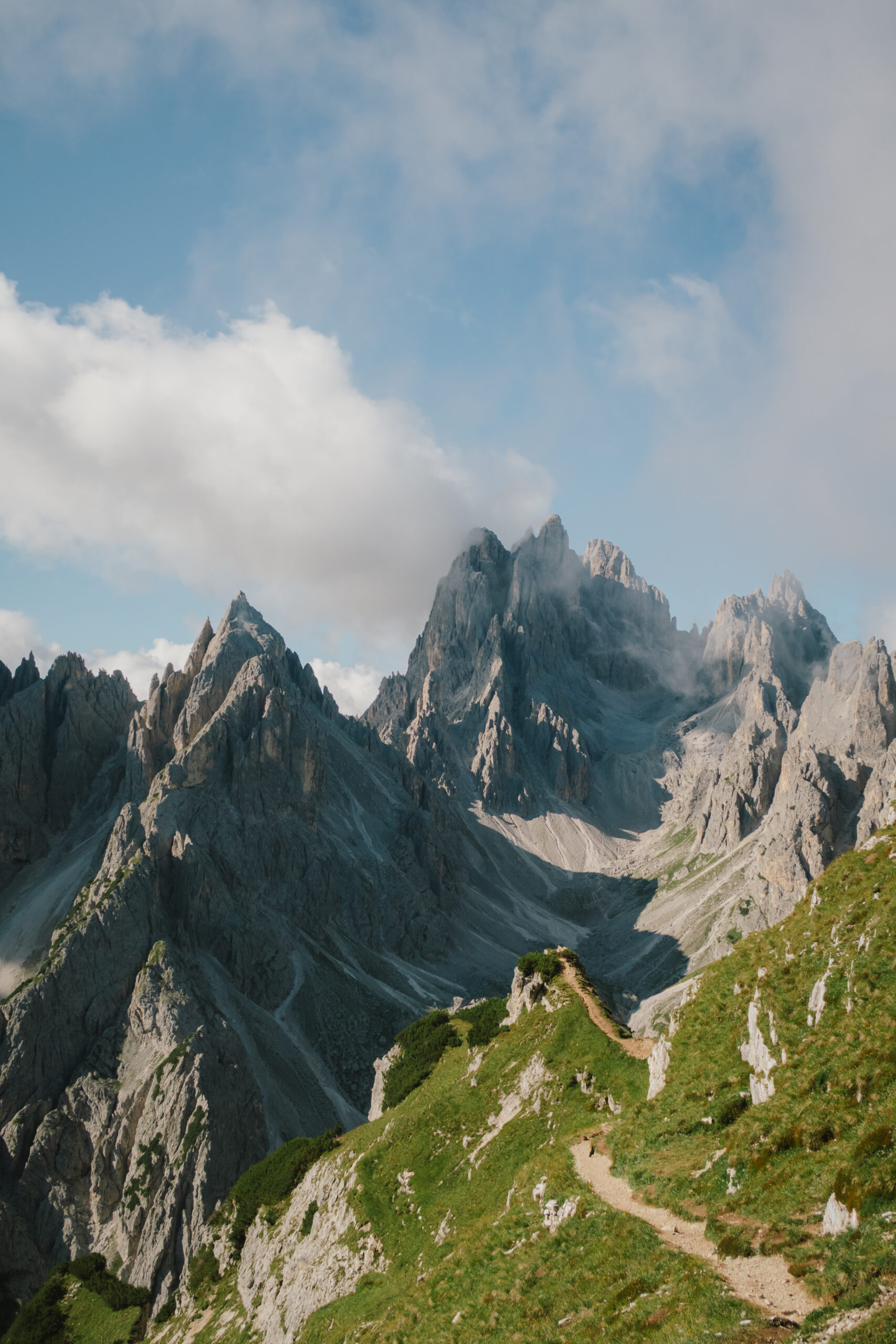

I just spent two incredible weeks exploring Northern Italy, and I can honestly say it was the perfect mix of adventure, relaxation, and breathtaking scenery. My journey began with a week on the sparkling shores of Lake Garda, where I wandered through charming lakeside towns, indulged in gourmet meals, and enjoyed boat rides on the turquoise water. Then I traded the tranquil lakes for the dramatic peaks of the Dolomites, hiking iconic trails, discovering hidden valleys, and unwinding in luxurious mountain retreats. From serene lakes to towering mountains, this trip gave me a firsthand experience of Northern Italy at its most beautiful and unforgettable.
Lake Garda:

You’ve heard of Lake Como, but have you heard of Lake Garda? If you’re dreaming of a place where sparkling waters meet pastel villages, ancient castles perch on hilltops, and gelato is a daily ritual—Lake Garda should be at the top of your travel list. Italy’s largest lake is a destination that blends relaxation and adventure, romance and culture, and a whole lot of jaw-dropping scenery. Whether you’re here for hiking, swimming, boating, wine-tasting, or just soaking up that dolce vita energy, Lake Garda offers something for every kind of traveler. I loved that it was less crowded than the popular Lake Como—there were still tourists, but they were all European. We didn’t run into a single American during our week there.
Things to do on Lake GardaTake a boat tour:
- Take a boat tour: Hop between towns or rent a private boat for a leisurely lake day.
- Lake activities: Find a quiet cove or beach club and dive in—especially in July and August. If you’re feeling more adventurous, try paragliding over the lake, kite surfing, or sailing.
- Go wine tasting: The Bardolino wine region offers amazing local wines and beautiful hilltop, lakeside views.
- Ride the cable car to Monte Baldo: Sweeping alpine and lake views, with trails for all levels.
- Explore by bike: Rent an e-bike to cruise along the lake’s scenic cycling paths.
Top Must-Visit Towns:
Lake Garda (Lago di Garda) straddles three Italian regions—Lombardy, Trentino-Alto Adige, and Veneto—each offering its own unique vibe. The northern shore is framed by dramatic mountains and attracts outdoor adventurers, while the southern towns are flatter, sun-drenched, and rich with history, vineyards, and charming old towns. It’s a place where you can hike in the morning, sail in the afternoon, and sip wine on a terrace by the sunset. Here are the top towns I recommend visiting:
Sirmione


Known as the “Pearl of the Lake,” this picturesque town is perched on a narrow peninsula jutting into the southern end of the lake.
Highlights include:
- Scaliger Castle: A fairytale-like fortress with lake views.
- Grotte di Catullo: Ruins of an ancient Roman villa overlooking the water.
- Thermal spas: Treat yourself at Aquaria Thermal Spa for the ultimate lakeside relaxation.
STAY:
Villa Cortine Palace
📍Location: Sirmione
The Villa Cortine Palace Hotel is a luxurious 5-star, 1 Michelin Key retreat set upon a hill in the heart of the peninsula of Sirmione in a lush private park with impressive statues and fountains overlooking Lake Garda. Housed in a stately neoclassical villa, it features opulent interiors, elegant guest rooms, and stunning gardens dotted with fountains and sculptures. With a private lakeside pier, tennis courts, and refined dining, it offers a secluded, romantic escape just steps from Sirmione’s historic center.
Malcesine
On the eastern shore, Malcesine is a storybook village with cobblestone alleys and a vibrant harbor.
- Monte Baldo Cable Car: Ride to the top for epic views and great hiking.
- Scaliger Castle (yes, another one!): With a museum and panoramic views from the tower.
- Water activities: Windsurfing, kayaking, and boat tours.
Limone sul Garda



This lemon-themed town reminiscent of Positano is on the northwest shore and is famous for its citrus groves and pastel buildings that cling to the cliffs.
- Limonaia del Castel: A historic lemon house turned museum.
- Lakeside promenades: Perfect for golden hour walks while eating their famous lemon sorbet.
- Scenic cycle path: The cliff-hugging path offers incredible lake views.
Riva del Garda
Located at the very northern tip of the lake, Riva is surrounded by alpine peaks and is ideal for nature lovers.
- Hiking and biking: Trails to waterfalls, castles, and scenic overlooks.
- Sailing and windsurfing: The wind conditions here are legendary.
- Old Town: Colorful streets, cozy cafés, and great shopping.
Bardolino


Nestled on the southeastern shore, Bardolino is known for its vibrant promenade, relaxed atmosphere, and, of course, its famous Bardolino red wine. Surrounded by vineyards and olive groves, it’s a dream destination for food and wine lovers.
- Bardolino wine route: Visit nearby wineries for tastings and local delicacies.
- Lakefront walks: One of the prettiest promenades on the lake—perfect for sunset strolls or morning jogs.
- Olive Oil Museum: A surprisingly interesting stop just outside town.
- Weekly market: Great for shopping, food stalls, and local crafts.
STAY:
Palace Hotel San Pietro
📍Location: Bardolino
4-Star Palace Hotel San Pietro Bardolino is a charming lakeside hotel located on the shores of Lake Garda, offering stunning views and elegant accommodations. Guests can relax in comfortable rooms and suites, enjoy local cuisine at the on-site rooftop restaurant, and unwind in the hotel’s wellness and leisure facilities. The hotel provides easy access to Bardolino’s historic center, vineyards, and lakeside promenade, making it ideal for both relaxation and exploration. This is a great budget friendly option!
Gardone Riviera



If you’re looking for elegance and a touch of old-world charm, Gardone Riviera is a refined and peaceful spot on Lake Garda’s western shore. It was once a haven for artists and aristocrats, and it still carries that grand, timeless feel.
- Botanical Garden (Heller Garden): An enchanting oasis of exotic plants, modern sculptures, and serene walking paths.
- Fine dining: Gardone is known for upscale Michelin-starred restaurants and lakeside cafes.
- Quiet luxury: Ideal for romantic getaways or wellness weekends with several luxury hotels to choose from.
STAY:
Grand Hotel Gardone
📍Location: Gardone Riviera
The 4-star Grand Hotel Gardone is an iconic 19th-century hotel set along the waterfront in Gardone Riviera on Lake Garda. Known for its classic elegance, it offers spacious rooms—many with balconies overlooking the lake—alongside a lakeside pool, private pier, and fine dining terrace. Its rich history and old-world charm, paired with modern comforts, make it a favorite for travelers seeking a timeless Lake Garda experience without breaking the bank.
Grand Hotel Fasano
📍Location: Gardone Riviera
The Grand Hotel Fasano is a historic five-star retreat on Lake Garda’s tranquil western shore in Gardone Riviera. Once an Austrian imperial hunting lodge, it blends Belle Époque elegance with modern luxury, surrounded by lush gardens and direct lake access. Guests enjoy refined rooms and suites—many with sweeping lake views—Michelin-starred dining, and the expansive AQVA Spa, making it a perfect escape for romance, relaxation, and lakeside exploration. (Book with me and get free perks like potential room upgrade, early check-in/late check-out, complimentary breakfast, and $100 resort credit- reach out to merissa.bradford@fora.travel)
Places to eat & drink on Lake Garda:
- Biri Bardolino: One of Bardolino’s top spots for foodies seeking a modern twist on Italian classics. The restaurant’s philosophy centers around seasonal ingredients, minimalist presentation, and bold flavor combinations. Expect dishes like homemade pasta with lake fish and citrus, veal with truffle cream, or local vegetables reimagined as gourmet starters.
- Hostaria al Buongusto in Limone: The kind of place you hope to stumble upon in Italy, this is a family-run restaurant where the food is honest, the service is kind, and the portions are generous. The menu features classic northern Italian and Veneto dishes, with rich flavors and rustic presentation—think slow-cooked beef in Amarone wine, fresh pasta with porcini mushrooms, and homemade tiramisu. Set in a courtyard with wisteria hanging from above, it is a scenic yet authentic spot.
- Il Fiore di Zucca: Tucked away in the hills of Gardone Riviera, this restaurant stands out for its dedicated gluten-free options and inventive menu. From gluten-free pizza and homemade pasta to seasonal vegetarian specials, the kitchen accommodates dietary needs without sacrificing flavor or quality. The staff is incredibly attentive and knowledgeable about allergens, making it a great choice for travelers with food sensitivities.
- Vecchia Malcesine: A Michelin-starred restaurant that is a true gem, perched above the lake in one of the prettiest towns. Chef Leandro Luppi creates bold, contemporary dishes with lake fish, herbs, and seasonal ingredients, all plated with artistic finesse. The tasting menu plays with textures and unexpected flavors while still feeling grounded in the region.
- Lido 84 in Gardone Riviera: Often considered one of Italy’s most exciting restaurants, Lido 84 has become a destination in itself. With a stunning lakeside setting and wildly inventive tasting menus, Chef Riccardo Camanini takes Italian tradition and gives it a modern, unexpected twist.
- Villa Feltrinelli: A two-Michelin-star restaurant. Housed in a grand 19th-century villa, surrounded by manicured gardens and overlooking the lake, it’s the definition of lakeside luxury. Chef Baiocco’s cuisine is elegant and delicate, using rare herbs and vegetables grown on-site. The experience is theatrical and timeless—more like dining in a living postcard.
Tips for Visiting Lake Garda:
- Best time to visit: Late May to early October for sunny days and warm water. Avoid August if you want to skip the peak crowds.
- Getting there: The nearest airports are Verona, Bergamo, and Milan. Renting a car is the best way to explore the whole lake.
- Getting around: Car, ferry, or bicycle. Ferries connect most towns and are a scenic way to travel.
- What to pack: Swimsuits, comfortable walking shoes, sun protection, and a light jacket for breezy evenings.
Dolomites:

After a week in Lake Garda, we rented a car and drove up to the Dolomites (around 2 hour drive depending where you’re coming from). The Dolomites had been on my bucket list for so long, and I finally got to experience it for myself. The photos truly don’t do it justice, and seeing the region with your own eyes is an absolute must. We spent a full week exploring the area while also relaxing at some amazing hotels.
What To Do In The Dolomites:
The Dolomites span a vast and diverse region, making it challenging to decide exactly what to see—especially if you’re short on time. If you’re visiting during the peak summer season, it’s essential to start your days as early as possible. Not only will you beat the crowds, but you’ll also avoid the frustration of full parking lots and long lines at popular spots. Early mornings in the Dolomites often come with crisp air, golden light, and a peacefulness that disappears by midday.
Here are my top recommendations for unforgettable places to visit and explore:
Lago di Braies: This picture-perfect lake is easily one of the most photographed spots in the Dolomites, and for good reason. The water shimmers in shades of turquoise and emerald, set against a dramatic backdrop of towering peaks and pine forests. It’s a magical place that feels almost unreal. Don’t miss the chance to walk the loop trail around the lake or rent a traditional wooden boat for a unique perspective.



Cadini di Misurina: This hike is a true hidden gem that feels like walking through a fantasy world. The jagged, spire-like peaks are mesmerizing, and the trail offers several jaw-dropping viewpoints along the way. It’s not overly long or difficult, but the payoff is extraordinary. A must for photographers and nature lovers alike.



Tre Cime di Lavaredo: One of the most iconic hikes in all of Italy, Tre Cime features three towering peaks that define the Dolomites skyline. The trailhead starts from the same parking lot as Cadini di Misurina, so you can easily do both in one adventurous day. The loop around the peaks offers sweeping alpine vistas, charming rifugi (mountain huts), and countless photo ops.


Seceda: Located in the heart of the Dolomites, it’s famous for its dramatic, jagged peaks and panoramic alpine views that are truly unforgettable. Accessible by cable car, it offers scenic hiking trails, ski slopes in winter, and endless photo opportunities year-round. The unique landscape, with its striking ridges and green meadows, makes Seceda a must-visit destination for nature lovers, adventure seekers, and photographers alike.



Val di Funes: This serene and picturesque valley is a postcard come to life. With rolling green meadows, quaint alpine farms, and the dramatic Odle mountain group as a backdrop, it’s hard to take a bad photo here. Don’t miss the historic churches of San Giovanni and Santa Maddalena—they’re small but incredibly scenic, especially at sunrise or sunset.


Alpe di Siusi (Seiser Alm): The largest alpine meadow in Europe, this high-altitude plateau is known for its wide-open landscapes, blooming wildflowers, and breathtaking views. It’s the perfect place for a relaxing walk, a scenic bike ride, or even a peaceful picnic. The sense of space and calm here is unmatched, and the panoramas go on for miles.


After your days of hiking, you can relax back at your hotel spa or pool and take in the views.
Where To Stay:
Choosing where to stay in the Dolomites is the hardest part of planning your trip! The must-visit spots are all very spread out, so it’s important to plan your stays accordingly. Here are some of the luxury hotels I recommend in the Dolomites that I stayed at and thoroughly enjoyed!
Forestis Dolomites



📍Location: Brixen/Bressanone
Tucked high above the forested slopes of Plose, Forestis is a sanctuary of calm and quiet sophistication. This adults-only, 5 star and 2 Michelin Key eco-conscious hideaway blends minimalist architecture with panoramic views of the Dolomites from every suite. Everything here is rooted in nature—from the locally sourced materials to the seasonal cuisine and holistic spa treatments inspired by the forest’s energy. The 7-course tasting dinners (available to guests only) change daily and focus on foraged and regional ingredients.
COMO Alpina Dolomites
📍Location: Alpe di Siusi (Seiser Alm)
Perched on the high-altitude plateau of Alpe di Siusi, 5 star and 1 Michelin Key COMO Alpina Dolomites is a stunning blend of contemporary architecture and warm alpine hospitality. Open year-round, it caters to both summer hikers and winter skiers with ski-in/ski-out access. Expect COMO’s signature wellness philosophy: an expansive spa, yoga and Pilates offerings, and healthy but indulgent cuisine. Interiors are stylish and calming, with natural stone, wood, and panoramic views throughout.
Hotel de Len
📍Location: Cortina d’Ampezzo
4 Star Hotel de Len brings a fresh, eco-luxury feel to the heart of Cortina d’Ampezzo. Owned by Egnazia Group (Borgo Egnazia), its name means “House of Wood,” and the interiors are crafted entirely from locally sourced materials, down to the larch and fir beams from nearby forests. Rooms are minimalist but cozy, with thoughtful design and wellness details like sound-absorbing walls and custom-made beds. The rooftop spa features an infrared sauna and hot tub with a view, while the in-house restaurant (on the Michelin guide) celebrates regional flavors with a modern twist throughout.
Dining in The Dolomites:
The Dolomites are known for their jaw-dropping scenery, but the culinary experiences here are just as unforgettable. Blending Austrian, Tyrolean, and Italian influences, the food in this region is hearty, seasonal, and deeply connected to the land. Whether you’re dining at a sleek Michelin-starred restaurant or enjoying a rustic hut meal with views for days, each spot offers its own unique charm.
- Forestis (elevated forest-to-table fine dining): If you’re staying at Forestis, you’re in for a truly exceptional culinary experience. Dinner is exclusively available to overnight guests, but it’s absolutely worth opting for the half-board package, which includes a seven-course tasting menu each evening. The dishes change nightly and are inspired entirely by the surrounding forest—think wild herbs, locally foraged mushrooms, game meats, and alpine roots reimagined into artful, contemporary plates. Everything is seasonal, sustainable, and beautifully presented.
- Alpina Chalet (cozy, authentic alpine cuisine): Located in the heart of Alpe di Siusi, Alpina Chalet offers traditional South Tyrolean comfort food with a warm, rustic vibe. Think handmade dumplings, rich polenta dishes, tender venison, and homemade desserts like apple strudel and Kaiserschmarrn. It’s the kind of place where you can linger after a day of hiking, glass of wine in hand, watching the light change on the peaks outside. During ski season, it’s a popular après-ski spot right on the slopes with a DJ.
- Baita Sofie Hütte (lunch with a view): At over 2,400 meters above sea level, Baita Sofie Hütte isn’t just a restaurant—it’s a full-on mountaintop experience. Located above the Seceda ridgeline, it’s the perfect lunch spot after a morning of hiking or skiing. The food here is hearty and traditional, featuring mountain favorites like goulash, dumplings, and grilled sausages, paired with Tyrolean wines and panoramic views that will stop you in your tracks.
- Restaurant de Len (modern mountain dining): For a more modern take on Dolomites cuisine, Restaurant de Len in Cortina d’Ampezzo blends upscale alpine design with creative farm-to-table dishes. This Michelin Guide menu is seasonal and refined, featuring locally sourced meats, fresh pastas, and regional produce presented with artistic flair. It’s ideal for a special dinner out or a relaxed but elevated dining experience after a day of exploring Cortina’s charming town center.
- Restaurant Pizzeria Al Passetto (casual pizza joint in Cortina d’Ampezzo): If you’re gluten-free, Al Passetto is a hidden gem that caters beautifully to celiac and gluten-sensitive travelers. Located in Cortina, this casual and welcoming spot serves up celiac-safe pizza with crispy thin crusts and all the traditional toppings you’d expect—from wood-fired margherita to rich truffle and mushroom combos. They take cross-contamination seriously, so you can dine here with confidence while still enjoying that classic Italian pizza experience. They also serve normal pastas and pizzas, so there’s something for everyone!
Tips for Visiting The Dolomites:


Exploring the Dolomites is an unforgettable experience, but a bit of planning goes a long way in making your trip smoother, safer, and more rewarding. Whether you’re visiting for the hiking, photography, skiing, or just the scenery, here are some key things to know before you go.
When to visit
- Summer (June–September): Best for hiking, biking, and outdoor exploration. Expect warm days, cool nights, and occasional afternoon storms. July and August are peak seasons—stunning, but crowded.
- Autumn (late September–mid-October): The golden larches and quieter trails make this a dream for photographers and peaceful nature lovers. Some hiking trails may close down for snow/ice.
- Winter (December–March): The Dolomites transform into a world-class ski destination. Think cozy mountain lodges, snow-covered villages, and legendary ski runs. The 2026 Winter Olympics will be hosted here!
- Spring (April–May): Less ideal, as many trails, hotels, and lifts are still closed. Snowmelt can make hiking unpredictable.
Hiking tips
- Start early: Parking lots fill up quickly, especially at Lago di Braies, Seceda, and Tre Cime. Arrive before 8 am if possible.
- Check conditions: Weather can change fast in the mountains. Always check forecasts before heading out, and be prepared to turn back if needed.
- Know your trails: Many hikes are family-friendly, but others require gear and experience. Don’t underestimate the terrain.
- Bring cash: Many rifugi (mountain huts) only accept cash, even for food or drinks.
Transportation & getting around
- Car rental is highly recommended: Public transport exists, but many of the best viewpoints and trailheads are best reached by car. Be prepared for mountain driving—narrow, winding roads and tight turns are common.
- Toll roads and parking: Some roads (like those to Tre Cime or Lago di Braies) charge tolls or have timed entry systems. Parking fees are common, and many spots require cash or coins.
- Public transport: If you don’t want to drive, regional buses connect major towns (like Bolzano, Ortisei, and Cortina), and cable cars help access higher elevations. The buses don’t get to the main sites until late morning, so you will arrive with the masses of tourists. If it’s in your budget to do private drivers/tours, that would be the most relaxing and efficient option.
Ready to plan you Northern Italy Trip? I am a travel agent and can help you with all your needs from transportation, itinerary building, hotel bookings with free VIP perks, and more! Reach out to me at merissa.bradford@fora.travel.
2 Weeks in Italy: Lake Garda & The Dolomites
I just spent two incredible weeks exploring Northern Italy, and I can honestly say it was the perfect mix of adventure, relaxation, and breathtaking scenery. My journey began with a week on the sparkling shores of Lake Garda, where I wandered through charming lakeside towns, indulged in gourmet meals, and enjoyed boat rides on the […]